
The Journal of the Dean Forest Railway
Magazine Dean Forest Railway
Issue 67 Summer RRP £2.50
Dean Forest Railway
The Journal of the Dean Forest Railway
About this magazine
The Journal of the Dean Forest Railway is a quarterly publication.
© Dean Forest Railway Society CIO, 2024
All rights reserved. No part of this publication may be reproduced, copied or transmitted in any form or means, or stored in any information storage or retrieval system without the written permission of the Dean Forest Railway Society.
Views expressed within this publication belong to their individual authors and are not necessarily those of the editors, the Dean Forest Railway family of organisations, the Society or its Trustees. The Dean Forest Railway Society accepts no liability or responsibility for any loss resulting from information provided in this publication.
How to submit an article
We prefer articles in electronic format (preferably Word) and high-resolution images to be emailed to the editors at: magazine@deanforestrailway.co.uk
Or by post to:
The Editors, DFR Magazine
Dean Forest Railway Society Norchard Forest Road, Lydney, GL15 4ET
This issue has been edited and produced by a team of volunteers and Trustees of the Society.
Laid out in Adobe InDesign & printed by Solopress.com.
Copy Deadline
Please send your reports, letters, comments, photographs and any other content for Issue 68 by, at the absolute latest: 2nd August 2024
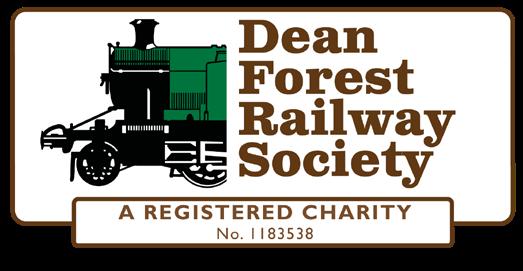
Front Cover: John Ennis (aka Eye In The Sky) captures the Lydney Town level crossing renewal from a completely different angle!
Rear Cover: During a photographic charter on Tuesday 14th May, James Shipley captures 9681 with ballast train passing the cottages at Whitecroft. The train has just passed over Grove Road foot crossing and approaches Oakenhill Wood No.1foot crossing.
All DFR Society post (donations, membership renewals and general correspondence) should be sent to: DFRS Honorary Secretary (Mrs. S. Williams) 109 Victoria Street Cinderford
2HU
www.dfrsociety.org.uk Magazine
In this issue From the Editors 1 Chairman’s Platform 2 Society News 3 Development In Brief 4 DMU Group Update 6 Peckett Progress 8 View from the Box 11 Parkend Monday Gang 12 Friends of Parkend Station 14 DFLG Dialogue 15 Carriage & Wagon 16 Membership Matters 19 Hill Street Blues 20 Trolley Tales 40 Old Relics II 42 DFDA Curtain Call 45 Beneath Your Wheels 46 Garden of Remembrance 47 Letters to the Editors 48 Historical Highlight 52 Who’s Who at the DFR 53
GL14
Gloucestershire
From the Editors
Dear Society Members,
It’s editor’s prerogative to complain about the lack of contributions submitted at every available opportunity. In all honesty, Issue 67 turned out to be no different, but all of a sudden – our shared email inbox was loaded.
For this bumper issue, there is a large focus on the Lydney Town Level Crossing Renewal. However, the smaller tasks are just as important and help keep us moving forward. It’s difficult to make a choice between what goes in and what gets held over to the next issue. Key factors include the size of the article, whether or not the content is timebound, and the number of submissions by the author.
Irrespective of that, please make every effort to submit content on a regular basis, this publication (to borrow a few select words from Abraham Lincoln) is “of the people, by the people, for the people”.
It is not the job of the editors to write the content (although we do regularly supply our own content), we take the many parts and make them whole. We cannot communicate what doesn't exist!
We’ve taken the bold step and chalked up the copy dates for the next three magazines, the plan is that the magazine is published in the first week of the following month.
All members with a valid email address on record will then be sent an electronic copy, with hard copies being mailed during the following week (the exception being those that have opted to receive the electronic copies only).
The upcoming deadlines are as follows:
• Issue 68, copy date: 2nd August
• Issue 69, copy date: 1st November
• Issue 70, copy date: 31st January
To maintain the standard that you have grown to know and love – we use the same fonts, sizes, and styles throughout:
Title: Clarendon Blk BT, size 36pt
Body: Gill Sans MT, size 11pt
For anyone putting content together you can use those parameters to help lay it out (if you like). Otherwise please use the regular font in your chosen software, set at size 11pt. Any images for inclusion need to be high quality. If you're unsure or any need advice, please do get in touch!
Letters to the Editors should be sent either by email to magazine@deanforestrailway.co.uk or by post to the DFRS Honorary Secretary – those received before the copy date are included towards the rear of the issue. As always, we value your support, and we remain dedicated to keeping you informed and connected within railway family.
With best wishes
Adam W, Ian & Tim
Your editorial team

DFR Magazine Issue 67 1
Left to Right: Adam Williams, Tim McLennan, Alastair Clarke, Alex Davies, Adam Dickinson, Ian Pope
Chairman’s Platform
Forest of Dean Railway Limited Chairman, Ian Pope looks back over some busy weeks.
The railway is back in full swing, and it is good to see services back up and running with lots of happy visitors enjoying the experience thanks to our many volunteers who make this possible. It is especially nice to see 9681 working services, it always brings back personal memories of watching pannier tanks operating services over our line in the early 1960s.
Since writing for the last issue, the railway has undertaken a major piece of work in the replacement of Lydney Town level crossing. I had the pleasure of attending on the Saturday doing ‘meet & greet’ with the public on the top side of the crossing. All that were spoken to were quite happy to take a diversion on foot via St. Mary’s footbridge, thankfully it was a nice sunny day. A number of the onlookers were also very interested in the tasks being undertaken and were impressed that the majority of the work was being done by volunteers.
The Company would not only like to say a very big thank you to the Permanent Way Department who planned the whole operation with such precision, but to the Signal & Telegraph Department and Telecoms. They worked alongside to ensure that all communications were restored as quickly as possible to allow the line to reopen.
Our thanks must also go to the DMU Group for working the Norchard-Parkend service whilst the line was severed.
Seeing the rails being ripped out of the tarmac on the Saturday morning took me back to the removal of Speech House Road level crossing in 1961/2 as illustrated below.
The fact that the core works were completed ahead of schedule, with the road closure being lifted early is a great compliment to the teams involved and to the close working between our volunteers and the various external contractors employed for specialist tasks.

We were fortunate to have good coverage on social media and it was interesting to hear the statistics that had been recorded with respect to Facebook posts about the work, the following figures were correct at the time of writing:
30th March – call to arms, post reached 13,264 users
10th April – track severing, reached 21,351 people
13th-15th April – core works, nine separate posts, by three individuals reached 102,390 users
17th April – track reconnection, post reached 16,362 users
The planning of the whole project should stand as a fine example for other major projects that are undoubtedly going to have to be undertaken on the railway in future.
Of the Companies the Forest of Dean Railway Ltd continues to plan the long-term future of the railway and Dean Forest Railway Company Ltd, continues to ensure the smooth day-to-day running of the railway in which they are supported by the Dean Forest Railway Society. We would like to record our thanks to Dr Alastair Clarke who has retired from both Boards for the sterling effort put in over recent years and for his role with the Society who he represented on the FoDR Board. Thanks also to John Clarke who has retired from the FoDR Board but continues on DFRCL. There will soon be announcements for specific roles that we would like to fill on the FoDR Board to help with the future development of the railway. Thus, we look forward to the summer season, hopefully blessed with good weather but without a heatwave steam ban. Thanks everybody.
Ian

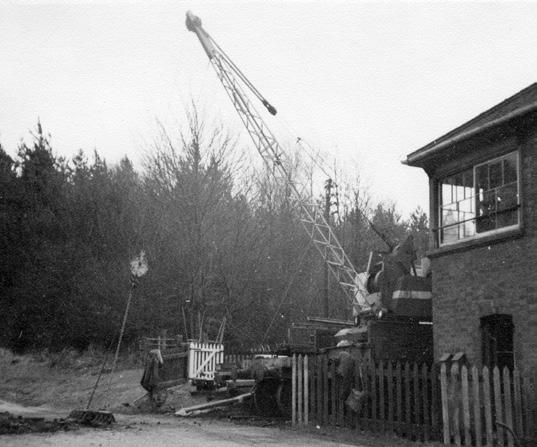
2
DFR Magazine Issue 67
The removal of the level crossing at Speech House Road is captured for posterity. (A. Pope)
Society News
Vice Chair of the Dean Forest Railway Society, Adam Williams gives a brief update from the Society. With a few of the Charity Trustees standing down over the preceding months, I would like to take this opportunity on behalf of us all to thank Alastair Clarke, Ian Pope, Stan Rudge, and Dan Winter for the contributions they give. Stan has done excellent work with our raffle over the years, whilst Alastair, Ian, and Dan were three of the first Trustees of the CIO and instrumental to the conversion of the Society to a registered charity on 22nd May 2019.
Ian continues as the Chairman of Forest of Dean Railway Limited and remains working away in that role, and I hope that we will continue to see everyone else about the DFR.
In the interim between the last 'proper' magazine (Issue 65) and now, James Graham (as the Vice Chair) offered to pick up the mantle of the Chairmanship (left vacant by Alastair Clarke). I offered myself to fill the resulting vacancy of Vice Chair, with the changes agreed by the Trustees.
Moving forwards, the 4th Annual General Meeting of the CIO was held on Sunday 19th May with a total of 74 attendees (of which 46 were in person, and 28 were via Zoom), apologies were received from 25 other members.
Resolutions (to approve the...) For Against Abstain
160 votes were cast representing a 13% turnout, for the voting regarding individuals a score is calculated by subtracting the number Against from the number For. Abstentions and Null votes (no boxes ticked) are classed as a zero.The ten candidates are ranked in order of highest to lowest score and the eight vacancies filled on that basis.
All three of the Trustees standing for re-election were so elected, and following on we welcome Ed Dyer, Alan Grant, Martin Hillier, Lynne Wentworth, and Peter Wood. All of whom have been elected to sit on the board of Trustees, our commiserations to Rob Alpin and Sam Bolingbroke.
On the behalf of all Trustees we would like to thank our three scrutineers – Tom Halford, Matt Sexton, and Andrew Woodrow for the sterling effort that they put in with a counting session which lasted for almost five hours!
Our thoughts turn to those that we have lost along the journey, for it's in their memory that we have to press forwards. Otherwise, their efforts would have been in vain. A fitting example was the day before the CIO AGM where we arranged with Granville's family to inter his ashes along the line, at the foot of Oakenhill, on approach to Parkend, his second home and a fitting final resting place for him. Granville's interment special arriving at Parkend. (P. Römer)

3 DFR Magazine Issue 67
Minutes of 3rd AGM (2023) 124 0 31 Trustees Annual Report (2022) 144 3 8 Audited Accounts (2022) 140 3 12
Score For Against Abstain Tim McLennan 61 104 43 10 Adam Williams 75 111 36 11 Sue Williams 88 117 29 13 Election of Trustees Score For Against Abstain Rob Alpin 54 93 39 19 Sam Bolingbroke 45 89 44 15 Ed Dyer 110 116 6 25 Alan Grant 95 108 13 27 Martin Hillier 84 108 24 19 Lynne Wentworth 71 105 34 15 Peter Wood 81 94 13 36
Re-election of Trustees
Development In Brief
Adam Dickinson details the feedback received, and answers questions on the development plans.
The publication of the previous magazine describing both our Aims and Objectives alongside our Development Plan was the result of a huge amount of work over the last few years. Started just before the Covid pandemic, and reestablished once we were sure that a sense of normality had returned, it has resulted in a pleasing amount of feedback so far. Some of the feedback was given as Letters to the Editors, with my response given here:
Aims and Objectives
Aim 3: Ensuring timetables take account of commercial requirements and staff availability.A number of our working volunteers raised that the two train days are important training turns for signal men, diesel crews and goods guards. When we were developing the 2024 calendar, one of the internal aims for running days like the Tanker Train days was staff training – they’re an all too rare opportunity to train our volunteers on unfitted trains, both loco crews and guards, as well as providing an attraction for members of the public. We’re looking at options for further training type events as part of developing the 2025 calendar.
Aim 9: Return to Speech House. Now that the bulk of the clearance work has been completed, allowing detailed site surveys – there will be a hiatus before there are shovels in the ground for substantial works at Lydney Junction
This is due to the planning and fundraising required, but there is an opportunity to make some progress on the extension. The track bed north of Parkend is within our boundary, and following approval by both the board of the DFR Co. Ltd and Forest of Dean Railway Ltd – over the winter of 24/25 we’ll start to clear vegetation, repair and reinstate the fences, as well as starting some trackwork. The headshunt has been slowly truncated over the years due to the deterioration of the wooden sleepers. These will be removed, the track bed graded, and then track laid on a new alignment that will effectively take a 'racing line' through the former double-track formation minimising the side loading on the old retaining walls whilst also reducing the future requirements for check-rails.
A replacement turnout has been planned for a while, and the track laid will be ‘extension ready’ – not only suitable for our operations today but also be suitable for operations in the future. This ties in with work that the Permanent Way department amongst others are planning for our fallow months. There are busy times ahead!
Once these works on the track north of the level crossing at Parkend have progressed to a suitable point we’ll be looking at the requirements to run brake van shuttles with Uskmouth 1, the DMU etc., to give our visitors an opportunity to experience the new section of line.
Developing the Railway
I held an ‘Ask Me Anything’ day, riding the train on Saturday 4th May, to give members who wouldn’t normally see me to come and do just that – ask me anything. If you missed it, I’ll be holding more during the year – dates to be confirmed. The below is a summary of questions asked:
Improvements to Norchard Car Park?
Making some substantial improvements to Norchard’s large car park are long overdue. The recent bad winters have exacerbated the potholes, with the water lying in them freezing and causing further damage, which then accelerates the deterioration. Due to the current car park surface, any attempt to simply fill them back in will be unsuccessful, as the filling material will not bind to the current surface. As the weather improves, we are planning to start a repair process across the car park, with a more substantial area removed around the damaged areas, suitable surface preparation, and then reinstatement in graduated layers, rolled in between each. We’re also looking at fencing, signage, lighting, and drainage.
Toilets behind the café?
When the current café was being planned, there was an aspiration to install toilet facilities behind the building. Unfortunately, due to the available services (both water supply and sewerage), this has not been able to be achieved without a significant civil engineering project across the site to improve those services. However, we are looking at some environmentally friendly alternatives with a much lower services demand, which has potential to resolve the issue. Alternatively, returning the toilets on the train into use has been investigated, but due to the cost of the project for retention tanks, pumping facilities etc, this has been discounted for the time being.
Toilets at Parkend?
Due to the layout of Parkend, the toilet provision is currently limited to the Down Platform. While this is fine on a one train day – the down platform being used for arrivals – on busier days with more than one train, and in the future with the prospect of trains arriving from North of Parkend, access between platforms is difficult for those unable to use the footbridge. I’ve taken this away as an area which will need further investigation.
Norchard Low Level crossing?
The foot crossing outside of the shop at Norchard has begun to deteriorate. Some repairs have been undertaken to reduce the risks, and with planned Permanent Way work through both the platform and loop at Norchard Low Level, more substantial repairs will be undertaken as part of that project. Rather than doing things piecemeal.
4 DFR Magazine Issue 67
Ticket office in the wrong place?
I’ll be discussing these issues and alternatives with relevant staff and volunteers, though with the current location we’re limited for providing covered waiting accommodation However, the area is also needed for deliveries, coal, manoeuvring plant etc – part of the reasoning for moving restoration to Lydney Junction is that we can turn Norchard in to a relatively ‘clean’ site. At present everything from children to coal, dogs to diesel, families to firebars, visitors to volunteers… access the same site, through the same gates, across the same bridge. That's even before we think about all of the waste!
There are obviously some quite different requirements, so if we can start to separate them out, we can provide a better solution all round. This ties back into the improvements to the car park – there's no hiding the fact that the surface gets hammered by the plant and machinery we use to operate the railway... We need to break out to Lydney Junction, it won't be tomorrow so we need to keep Norchard's patchwork quilt together whilst we do.
Norchard High Level platform?
In the medium-term future, the High Level platform at Norchard will require substantial remedial works. While this work is being undertaken, it has been suggested that the platform itself is extended to better accommodate our normal rake of five coaches – this has been factored into the investigations that are taking place.
Lydney Junction security?
The issue of security at Lydney Junction has been raised, as the details in the plans were relatively limited in the development plans. I just wanted to reassure everyone that CCTV is currently in the process of being installed, and security fencing will be designed once the final position of the buildings and facilities have been confirmed.
In addition to the ‘big ticket’ items for the development of the railway, there are a number of improvements we’re looking to make in the shorter term, including:
• Loco water supplies at Lydney Junction
• Improvements to road/rail loading at Lydney Junction
• Fencing between the railway and Bathurst Park
• Completion of the trough route at Lydney Town
• Repairs to culverts and drainage along the line in coordination with other planned works
We have to do some coordination with external parties on a couple of these items first, but we'll keep updated as we start to develop our railway for the future.
There will be opportunities for everyone to get involved – so keep an eye on the magazine, email newsletter, notice board, HOPS and the Facebook pages for regular updates.
Norchard Yard after the track alterations to connect the new inspection pit, a full write-up will be in Issue 68! (A. Williams)

5 DFR Magazine Issue 67
DMU Group Update
Alan Pace gives a run through their activities from the first quarter of 2024, whilst operating, maintaining, and planning some major refurbishment work on the fleet of excellently-restored vehicles.
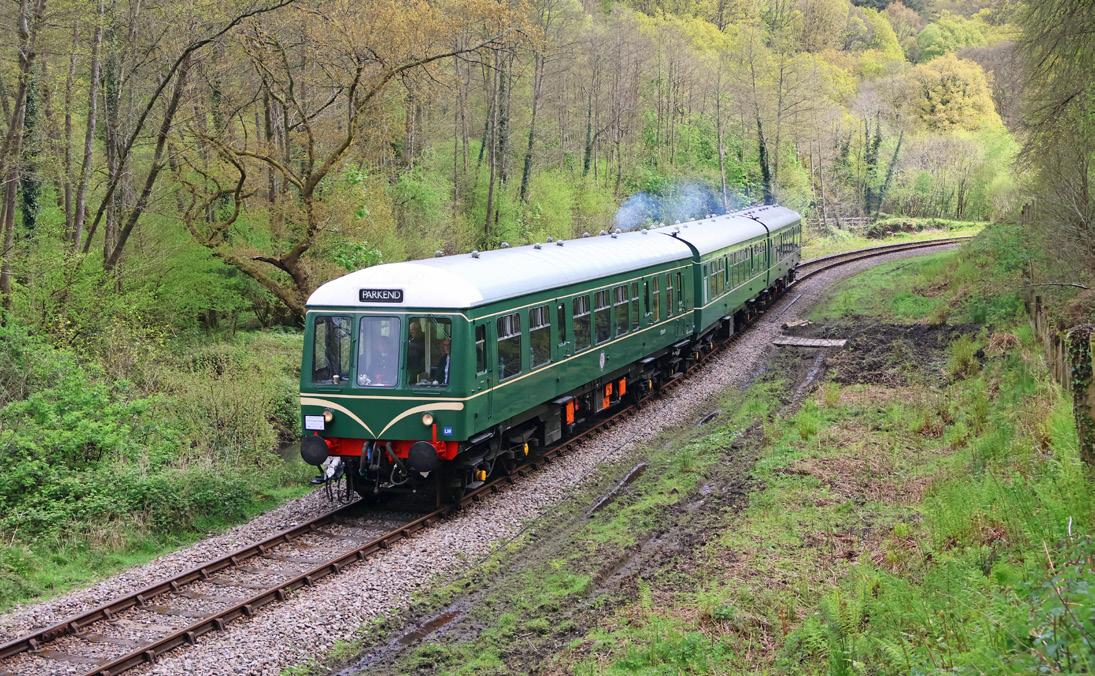
A DMU was used to work DFR passenger services during the track replacement work at Lydney Town level crossing. Forest Flyer services ran between Norchard and Parkend while the southern part of the line was closed, so the DMU group played an important part in keeping the DFR running during this temporary period of disruption.
A 3-car set using E50619, E59387, M51566 was provided for these duties. The level crossing track renewal was a major project for the DFR, it involved a huge amount of work and a big thank you goes to all those who put so much time and effort into it.
Our DMU group working members have been busy with maintenance and servicing work. During the winter the fluid flywheel on E50619 No. 1 engine required replacement. This item is mounted on the output end of the engine and transmits torque to the gearbox. The work was done with the engine still mounted under the vehicle, it proved quite difficult to remove and replace this heavy item from the shallow pit but with a bit of innovation and learning the job was done.
Following on from this the input seal for the No. 1 gearbox on that vehicle which had been leaking was replaced. A Smiths heater was tested and fitted to M51566.
To prepare the vehicles for service the team worked on the necessary inspections, with A exams being done on E50619 and E59387 and a B exam done on M51566.
These exams are in addition to the repair and maintenance work. They use the Railcar Association templates which are derived from the exams that British Railways used.
A test run with these three vehicles took place on 19th March, this identified some minor issues and was also a good opportunity to visit Parkend Post Office café for refreshments.
The set was given a thorough exterior and interior clean before being deployed on the Forest Flyer duties for the early part of the DFR running season.The DMU performed well, and it was pleasing to receive many comments on the good condition of the vehicles. Passengers were able to enjoy good views of this scenic part of the line.
The class 108 DMUs were built with aluminium bodies and steel ends. All of our cab ends have been replaced due to corrosion of the original metalwork. Some of the rear ends are now in a poor condition so we have plans to replace the sheet metalwork using a single piece aluminium fabrication. No original drawings have been found but we do have a scrap rear end to use as a pattern and Harold Counsell has put his draughtsman skills to good use producing a sketch for estimating purposes.
At the time of writing discussions were ongoing with a potential supplier. This is a major project for our group involving a lot of work. The plan would be to start with E50619 which appears to be in the worst condition.
6 DFR Magazine Issue 67
Experience from replacing the fronts suggests that there will be some work to do on the internal framework before fitting the new end. As the vehicle will need to be out of service for some time, we are progressing the necessary work to return M51914 to service. Some exam work has been carried out and a leaking fuel tap replaced.
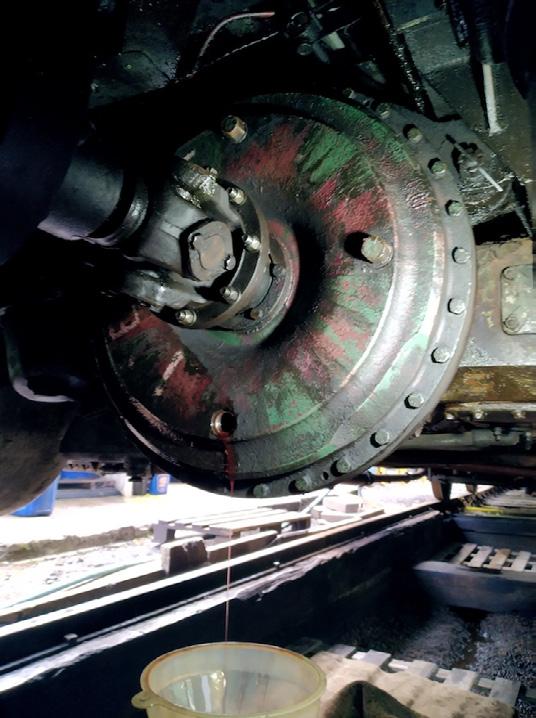
Other jobs planned for the future are an engine replacement on M51566 and some depot infrastructure work. There always seems to be lots to do so if you are interested and want to find out more let us know, email dmugroup@deanforestrailway.co.uk or come along for a chat, working days are normally held on Wednesdays.

Left: Draining oil from the fluid flywheel before dismantling. (R. Arthur)
Below: Exterior cleaning on 20th March 2024. (R. Arthur)

7 DFR Magazine Issue 67
Above: Input of the gearbox with pulley and bearing removed. (C. Walker)
Opposite page: E50619, E59387 and M51566 with a Forest Flyer service above Upper Forge on 1st May 2024. (A. Pace)
Peckett Progress
The most exciting update is that the engine has been rewheeled, and the boiler fitted in the frames. Once we had received the drawings, a new set of crown brasses were cast for the axle boxes. The previous set were scrap due to excessive scoring, caused by the fixed springing being incorrectly assembled. The uneven weight distribution on the wheels had often caused the engine to run hot during its previous ticket. Once these had been delivered, they were machined and fitted by Western Steam Engineering. All of the coupling and connecting rod bearings have been white metalled and machined. Under normal circumstances Peckett locomotive rod bearings do not have a layer of white metal, however, this was necessary because the crank-pins have been machined down to remove scoring, which meant we had to add material to the bearings. The bearings had serrations machined into them to allow white metal to bind to the surface. A jig was fabricated so that each bearing half could be clamped on, with any gaps being sealed with fire cement before the white metal could be melted and poured. Once cooled, the halves were then clamped together and machined. The coupling rod centres could then be set, and the rods fitted to the engine.
The water tank has been repaired, with new inner and outer plates fitted to the lower sections of the tank. The bottom of the tank had become severely corroded due to water sitting in the bottom of the tank over time.
While these new sections were welded to the tank, we wanted it to look as original as possible. To do this, holes were drilled in the new sections and dummy rivets have been welded in to give the appearance that the new sections have actually been riveted on. The opportunity was taken to modify the tank by replacing all of the bolt holes with threaded bosses which were welded into the tank. This eliminates the future need for anyone to climb into the tank to tighten nuts from the inside.
Photos from our early open days at Parkend show that the engine arrived without a tank lid. While one had been made many years ago from what was to hand at the time, in this case – a piece of plate with a length of pipe welded on as a handle.Whilst this lid did the job that was intended for, it has now been removed and a new one that is more befitting of a steam locomotive has been fabricated. The brass dome cover was found to be badly damaged, with large dents and sections hacksawed off. This had been hidden by filler, and paint, and was only discovered once it had been cleaned. Ed Freeman repaired the cover by knocking out the dents and brazing in new brass sections.
Something that makes Uskmouth 1 a rather unique locomotive is the sanding system. The engine was one of only two locomotives that were built by Peckett & Sons


Top: The saddle tank undergoing significant repair work.
Above: The wheel-sets with the machined axle-boxes fitted
Below: A new crown brass being checked on the journal.

(Photos: C. Bayliss)
8 DFR Magazine Issue 67
that used Lambert Wet Sanders (the other one being
Callum Bayliss updates on the restoration of Peckett No.2147 Uskmouth 1
This is a French design using hot water supplied from the boiler mixed with sand to create a slurry. This system was fitted to some of the S&DJR 7F’s when built, however they were later converted to use steam sanders. To our knowledge, this engine is the only surviving British standard gauge locomotive to still be fitted with an original imported Lambert system. Bagnall locomotives No.'s. 401 to 403 were fitted with a version made under licence by Gresham & Craven, which is still in service on No. 401.
Unfortunately, the pipework and many fittings were stolen years ago leaving us with the task of replacing the many missing components. Many replacement items have already been sourced, such as a steam fountain and castings for the steam valves (which will all need machining), this still leaves us needing to produce all new pipework. A new reverser lever catch handle has been produced from a piece of solid brass bar because like the majority of the original brass and copper work, it had been stolen. Another missing item was one of the Peckett works-plates which are fixed to the cab sides. If anyone has any knowledge of where this may be, please get in touch as we would love to have both originals again. We are arranging for a matching pair to be produced from the remaining plate in the meantime.
Now that the engine has been re-wheeled, new vacuum and steam heat systems can be designed. The previous affairs made from screwed pipe fittings. Steam heat was only fitted to the rear of the engine, this will be rectified. The new pipework will be flanged so that it can be easily removed whilst being as inconspicuous as possible.
We have sourced two small Great Western toolboxes which will be bolted to the back of the cab. These toolboxes are of the type that were fitted to the early pannier tanks, and have four holes in the lid, where a rudimentary wooden seat is fitted. One toolbox is in good condition; however, the other requires remedial work as it suffered significant fire damage at some point in its past.
The whistle and whistle valve are all one piece, and when built the valve would have been screwed into the dome cover. However, there was an incident many years ago where the section that threaded into the dome cover fractured. A repair was made at the time and the whistle and whistle valve had a flange brazed on, however there was no mechanical fix. Ed Freeman removed the old flange, cleaned off the old braze and machined a thread onto the whistle valve. A new flange was made with a tapped hole for the whistle valve to screw into. This was then brazed, and the whistle has been polished ready to fit to the engine.
The safety valves required work because the seating face on the base was incorrect. The drawings show the safety valve seating face as being 0.010” wide, whereas when we dismantled our safety valves, we found that the faces were extremely wider. Therefore, we set the bases up in the lathe and re-machined them back into tolerance.
Finally, the boiler is complete and has been tested out of the frames. All the new copper stays have been fitted and rivetted over, with the new front tube-plate rivetted on.
Work had been paused on the boiler to allow for the bottom end to catch up, but with the engine at a stage where the boiler could be refitted, it has been successfully tested in the presence of our boiler inspector. Slow and careful re-assembly and painting now follows...

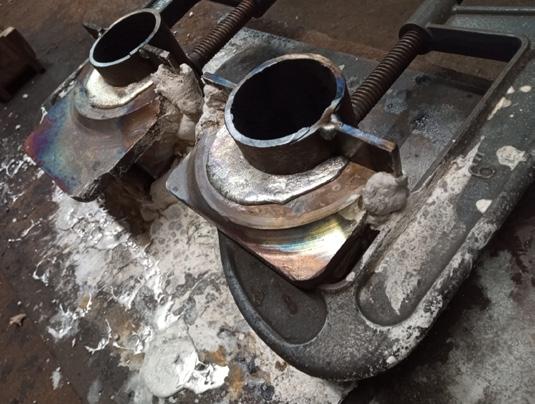
Top: The bearing halves with the machined serrations.
Above: White-metalled bearing halves in the fabricated jig.
Below: The clamped bearing being set up before machining.
(Photos: C. Bayliss)

9 DFR Magazine Issue 67



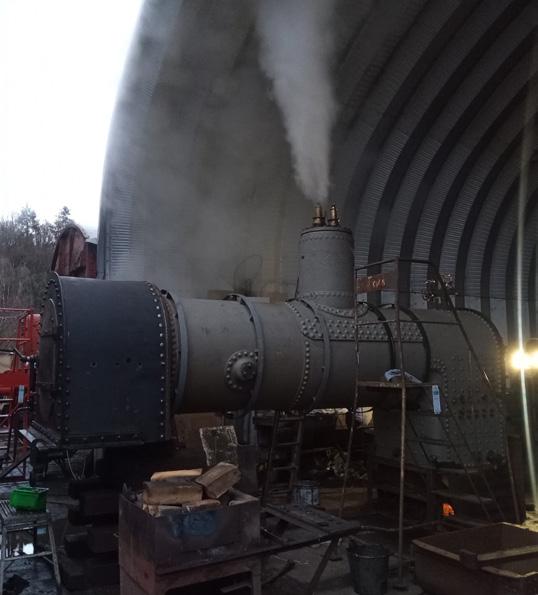
Above Left: The new tube-plate is rivetted on to the boiler.
Above: As hinted in Issue 65, the Boiler Inspector was due to examine 5541 and 9681, so new tubes were carefully fitted and an out-of-frames test arranged. A successful test meant assembly could begin, the Boiler Inspector will visit again for an in-frames test from when the 10-year clock will start ticking.
Left: The boiler, tanks and coupling rods are fitted to the engine, and the tedious process of painting and lining-out begins.
(Photos: C. Bayliss)
Below Left: Craig Morris masks out the panelling, nearly every panel of the locomotive is being lined out – evidenced by the Peckett works photos of both Uskmouth 1 and Uskmouth 2
Below: With all of the black edging completed, the locomotive is ready to be lined-out. The nameplates have been re-fitted to the tanks to ensure that the lining is level in respect to them.
(Photos: A. Williams)

10 DFR Magazine Issue 67
View from the Box
Adrian
Copley, DFR Operating Manager,
reports on another busy start to the season.
Ready, steady, go!
The 2024 season kicked off on Wednesday 13th March with the steam service travelling the usual route of the DFR and without any trouble for the rest of the month. The go-ahead for the Level Crossing renewal was given a week later on the 20th, works trains were organised to deliver and collect materials for the extensive renewal works at Lydney Town Level Crossing.
As described in the last edition, the ‘Special Key Token’ was introduced for non-passenger movements between Norchard Low Level and High Level especially for the diesel unit service between Norchard and Parkend during the blockade at Lydney Town. This passenger service ran faultlessly thanks to the dedicated DMU team and carrying a good loading of passengers on some days.
Then came a small fly in the ointment! Some filming work was shoe horned into the last weekend of the Level Crossing works requiring a rail movement of a Class 315 coach from Lydney Junction to Norchard (and back again). Luckily the work at the crossing had progressed to a stage that could allow the movement to take place, which was ably carried out by a small, efficient team. Thank you!
The crossing renewal job was well planned and the hand back of the line to operations was in line with that plan enabling our normal steam service to recommence on Saturday 4th May, although with a speed restriction and some peripheral work still to be completed at the crossing. In the meantime a couple of alterations were required by commercial to some timetables, so I set to and completed this work conferring with our timetable gurus. Because of the crossing works we were not able to arrange any guest locomotives for the spring gala, therefore it was decided that it would be a DFR Branch-line weekend. I gave the synopsis to the timetable gurus who produced the timetable. More printing and distribution followed...
Another plan was then launched (after a period of stagnation) to re-connect the new pit road at Norchard with upgrade work to the adjacent siding and this was to start on, yes you guessed it, the Branch-line weekend!
This will involve shunting stock around Norchard to enable coaling and stock access to keep our operating requirements flowing. Another cunning plan awaits for this work as I write this and a few more are afoot for the winter to carry out essential works elsewhere on the line.
Remember folks pre-planning prevents poor performance!
On Tuesday 14th May, my alarm sounded at 04:00 (just like real railway shift work)! The weather was not good, and was rather damp as the rostered driver and myself departed Bristol half an hour later for ‘Norchard in the sunny Forest of Dean’ (to quote a certain station announcer).
Yes, it was a photo charter day, a day with 9681 and a train of eight Dogfish ballast wagons and about thirty-five photographers (my job during the day was like herding cats!). The weather forecast was wrong as the sun did appear in the morning, although it hid during the afternoon.
Even though the weather wasn’t what was wanted, everyone seemed to enjoy the day and got some great shots, going home contented. The staff had a long day and were glad to get home, having a moan ‘why do we do it’, but we will be back again... Probably in October.
The early start reminded me of the 1960s when my maternal Grandfather, who was a passenger guard based at Yeovil Town, used to leave early in the morning whistling as he pushed his red and cream Honda 50 down the path (so as not to wake us and the neighbours!) to work the first down train of the day, the 06:30 to Ilfracombe as far as Exeter Central (hauled by one of 72C’s ‘U’ class locos).
I don’t think that a lot of people realise what is actually involved in organising just one of these special days as it all takes place behind the scenes. Stock has to be found, brought to Norchard before the day and returned afterwards, as well as the work required on the day.
The photographers expect to start as soon as the sun rises over Norchard about 08:00 and finish where ever the last spot is along the line to have sun. My thanks go to the Thursday shunting team who do a lot of the requisite shunting, sometimes with last minute instructions! With Summer around the corner, will my camera be busy? Will the sun shine?
We are trying a couple of children’s events later this year with ‘Forest Railway Stories’ at the end of June and ‘Teddy Bears Picnics’ in August – there’s even a promise of faces for locos! There may be nightmares of Thomas for some? Until next time... Take care.
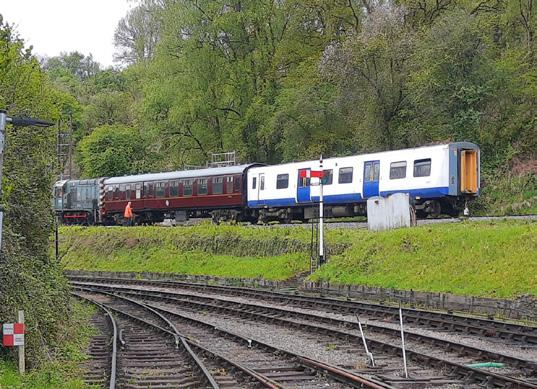
11 DFR Magazine Issue 67
Preparing the Class 315 coach for filming. (B. Thomas)
Parkend Monday Gang
George Smith reports on the activities of the Parkend Monday Gang.

This report spans from September to May.
Several long holidays in warmer climates, Bank Holidays, and sadly the loss of one of our team and have conspired to reduce our working man-days – as reported in Issue 65, sadly Granville passed away in January.
As one of the team he will be missed by us and the railway as he was also the de facto Parkend Station Master and Crossing Keeper. He had done a lot for the railway at Parkend notably building the drain chambers and their covers, painting fences, and making the walking paths as well as being the key holder and budget holder.
Retaining Wall Repairs
I reported in the last issue that we had finished the repair of a 10-metre section of the embankment retaining wall between the Up starting signal and Whitemead Park foot crossing. This had bulged to be about six inches out of line. There are several more sections that need attention with another being started in May. Following this first repair, we created a cess by removing excess ballast at the base of the wall. The ballast was sifted and used to fill a depression near the Permanent Way hut.
Vegetation has been cleared above the wall around and to the south of the Up starting signal.
Whitemead Park Foot Crossing
At Whitemead foot crossing, the post of the western outer gate holding the hinge and gate had broken at ground level and the gate was found lying on the ground.
The post was dug out and a replacement sourced which was soaked in preservative for a week before marking and drilling before installation. After initial packing, the gate was rehung in order to check its fitting. The gate hinges were fully fitted and adjust to give the correct alignment.
The closing weight consisting of a fishplate on a pulley was re-attached but as there was not enough leverage to swing the gate back from being fully open to closed, so the return spring had to be refitted.
Permanent Way Hut
The felt closest to the chimney had been blown back due to the strong winds. This section of the roof needs to be replaced a temporary fix was undertaken. The felt was pulled back and held down with an old gate post. The panel will be replaced in the warmer and drier months.
We widened, lowered, and levelled the path on the north side of the hut taking away at least four barrow loads of soil. It is intended to pave this area.
Redundant Ground Frame
The disconnected and redundant ground frame has been partially dismantled. The platform has been lifted and is now next to the cabin ready for removal. With nuts loosened or removed the frame is now ready to be lifted out by crane and taken away. Fine grit recovered from the ground frame pit has been spread on the path.
Water Crane
A recent burst water main had brought down a lot of detritus from the path above the bridge. The area around the crane was swept and tidied. To investigate the leaking valve on the water crane, the aluminium cover plate was removed to gain access to the valve underground. A short ladder and a slim person is required to access the pit and the six bolts securing the cover plate of the water valve need two 30mm spanners to remove them. As we were unable to lift the cover plate – possibly due to the use of gasket sealant, the bolts were refitted, and the tread plate put back in place. Unfortunately, the leak persists...
12 DFR Magazine Issue 67
Platform steps
The steps for the public to access the platform had deteriorated with the surface crumbling. With shuttering cut, barriers and diversion signs in place, the base of the steps was cut away and re-poured with a new layer of ordinary concrete.To even out the heights of the steps the height of each was made to be 155mm.
A 9-inch disc cutter was used to section the top two inches of each step and a jack hammer used to break apart the sections. With shuttering fixed to the riser, granite chips, sharp sand, and cement in the ratio 4:1:2 was used to make the concrete. With the base step set, steps 1 and 3 were cut away and re-poured. Step 2 was in reasonable condition.The fourth step was then cut out and re-poured.
Running In Board
During winter gales the running in board on Platform 2 had fallen over due to the timbers rotting at ground level. The old stumps were dug out and the holes cleared out to a depth of 30 inches The first new post was lowered into the hole and when vertical and the front face made parallel to the platform edge, small stone was back-filled into the lower half of the hole.
After tamping down the rest of the hole was filled and tamped. The second post was fitted in the same manner. Fine stone was applied to the surrounding surface and raked level. The two posts were sanded and then primed and under-coated and then painted by FOPS. The painting and erection of the station sign was carried out by the FOPS gang.
Grass Embankment
The west embankment between the north of the PW hut and the photographer’s enclosure had become a dumping ground for surplus soil, drainpipes, timber, rail chairs, chair screws and tie bars. This area has been cleared over a period of several months and the heaps of soil removed, and the ground lowered and levelled.
Over 200 barrow loads of soil were loaded, wheeled, and tipped ready to fill the depression in front of the now redundant Ground Frame cabin and to fill the area it occupies when it is removed. Each barrow had to be lifted over the signal wires and point rodding.
Station Buildings
Leaves and pine needles were removed from the gutter of the waiting shelter which had started to grow new seedlings. As the ladders were at hand, we cleared the front gutter of the station building and then inspected the roof of the gent’s toilet to identify the issue of a water leak next to the door. We could not identify the problem.
FOPS had asked us if we knew how to cancel the alarm in the disabled toilet. It issues a very quiet high-pitched squeak in the toilet and a slightly louder alarm and flashing sign in the booking office. The sounder in the toilet could not be heard beyond the closed door and that in the office could not be heard much beyond the outside window.



After cold weather in January, there was a leak in the cold water feed pipe to the wash basin in the Gents toilet. This was repaired by George but the main stop cock in the cubicle was attended to by a professional plumber.
Finally
We have a list of jobs that need doing but with just four we would welcome some new people to the team. No experience necessary. If you can push a barrow, use a shovel, a paint brush, a hammer, or a screwdriver and are willing to pitch in please come along on a Monday.
We all meet from 09:30, weather permitting.
13 DFR Magazine Issue 67
FOPS Update
Stuart Bearne reports on the activities of the Friends of Parkend Station group.
Work at Parkend Station has continued on several major projects plus the usual assortment of minor touch up jobs!
The purchase of anti-skid treads for the bridge steps has allowed the replacement of the of the step surfaces which now look much improved. The edging pieces have all been removed, repainted, and then refitted. This has improved the visual presentation of the bridge, especially when viewed from the platforms, Trevor and Ken have done a great job of refitting these items.
A significant amount of time has been spent by all the team in removing any loose paintwork from the platform edge white line area. FOPS have applied a coat of white masonry paint to both Platform 1 and 2 edging which sets off the rest of the platform buildings and improves the presentation of the many photographs taken at the station.
Attention has been given to the various platform signs and where necessary, replacements installed. Track bed and platform weeding continues on an “as and when” basis as, again, this does impact on the presentation of the station.
Work has begun on the Signal Box windows and panels overlooking the Fountain Inn. Time will be spent on any parts of the main station building that require repainting. Platform benches have also been repainted as necessary.
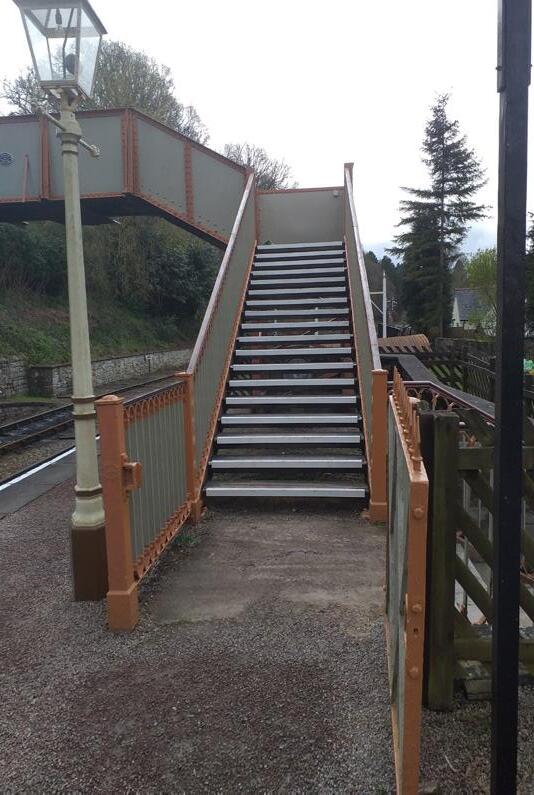
The crossing gates on the Speech House side have also required attention and some rotting wood has been removed with these areas being treated with preservative, filled with wood filler, and then repainted.
The floors of the waiting room and gent’s toilet have recently been repainted and similar work will be undertaken in the ladies and disabled toilets as time allows.
The sale of books from the Parkend waiting room continues to go well and many thanks to all those who have donated railway and transport books. The proceeds from these sales all go towards the purchase of maintenance items and also funds the cutting of the grass in summer months. Any further railway or transport books that can be spared will be welcomed at Parkend!
Jon Barry has recently joined us on Tuesday mornings and is currently cleaning and maintaining the various wagons on the Parkend site.This, again, will greatly assist in keeping things looking their best.We nearly had some help from the local sheep – who kept a careful eye on the proceedings from underneath the Midland Railway 3-plank wagon
We meet on Tuesday mornings at Parkend station, and a warm welcome is guaranteed for anyone who would like to come and join our friendly group of FOPS.

14 DFR Magazine Issue 67
DFLG Dialogue
Matt Sexton updates on the goings on of the DFLG, and Hilary Hill updates on the group's shop.
Firstly, a big thank you to the dedicated volunteers who often work late into the night (and early hours) to keep the engines running and move the restorations forward.
GWR Prairie 5541
The loco is performing well, in its last year before withdrawal for major overhaul. It is amazing to think it has been in traffic nearly ten years! The 2024 season has seen some issues, a broken spring, and a legacy (probably BR) repair to the hanging bar frame had to be reworked. Both of these activities were swiftly carried out by Western Steam Engineering to get the loco back in traffic.
BR (GW) Pannier Tank 9681
Working well in its second year of service after overhaul.
BR (GW) Pannier Tank 9682
Restoration is coming on well with the new rear buffer beam, drag box and floor fitted. The steam brake cylinder has been refurbished and refitted. Work has now started on fabricating a new cab and bunker. From experience with 9681 we ordered the profile sections in one go and are now in the process of drilling and riveting them together. We are checking the CAD models for the new cylinder block ahead of manufacturing 3D printed patterns and cores. We are also doing a lot of work to ensure that we can find an equivalent grade of cast iron to the material that was originally used by Swindon Works back in 1950.
Tom Halford and Ed Freeman have been sourcing new castings and parts to replace those that were lost or stolen before we purchased the engine. All of this costs money, and we expect to spend £90,000 on the restoration this year including the £50,000 for the cylinder block.
GWR Toad Brake Van 17448
The steel side plating has been replaced and under-coated by Doug Phelps and Sam Rees. The hard wood floor has been fitted in the cabin under the direction of Richard Thacker. The flooring under the veranda will be laid after the ballast for extra adhesion and also to trim the van.
Two Side lamps and a Guard’s hand-lamp that were previously sourced and used by Adam Williams, have been expertly restored by Chris Mackie. Also, we have managed to acquire a GWR Goods Tail Lamp, which Chris is also going to restore. The next steps are to complete the floor and start to rebuild the internal lockers. The new floor will then give the working platform from which the cabin planking can be rebuilt, and the roofing assessed.
Fruit D 3411
A bit of TLC is required, as a number of side planks have started to deteriorate, and we are keen to get these replaced over the summer before things get out of hand.
Collett Composite Brake Coach 7362
The coach kindly donated by Bill Parker, has been quietly ticking over in the background. Hannah Kingdon, one of our new Trustees, has volunteered to take over as custodian and is already chasing down parts we require. Recently we have managed to acquire a GWR passenger (traffic department) tail lamp for the vehicle. Our current plan is to start restoration when the Toad and our Mink A (currently on hold) projects are completed. Obviously, this is dependent on time and financial resources.
Acquisitions
We purchased two vehicles from the Company for nominal amounts, both residing at Lydney Junction. A Siphon G previously subjected to an Arson attack and beyond economic repair. We have salvaged fittings and will use components (e.g. bogies) as spares for our projects.
The other is a rare Mink D built in 1906, one of only six known to have survived. We have no immediate plans for restoration, but it was a vehicle for the future.
Sales Coach News
Sales are buoyant this season partly due to a large amount of new stock of boxed and unboxed locos, coaches, and wagons. Sales of railway books continues well.
Among the locos we have two Hornby boxed A4s, Mallard and Golden Shuttle, both DCC ready and in mint condition, and a Bachmann LNER 2-6-0 Sir William Gray and BR Class 20 8164 (DCC ready) both again in mint condition. For Manchester United fans there is a Hornby 4-6-0 61662. One interesting locomotive is a Lima HO gauge 141R SNCF 1097 (loco driven) with French/Italian couplings. Please take a look at: www.deanforestlocogroup.org
Coaches include Hornby Royal Train Duke, Queen, and Mk 3 coaches, Hornby, and Lima boxed coaches LNER, LMS, GWR and BR. Boxed Lima wagons include Siphon G’s, Palethorpe’s Sausages, Parcels Express, and GUVs. Unboxed wagons of all sorts including some Hornby Dublo (2 rail) wagons.
For railway modellers we have electronic modules both Signal and Telegraph and Heathcote with instructions. We are unable to display all the stock at any one time but there is a complete list of items in the coach so please ask to see this and we will find what you are looking for.
No magazines please! Simply... They do not sell. We are always happy to receive railways books in good condition (preferably not ‘coffee table’ books) particularly any relating to local lines; and good quality (paperback preferably) fiction and non-fiction.
For requests contact Hilary, via: hilary.a.hill@outlook.com
15 DFR Magazine Issue 67
Carriage & Wagon
Dave Chappell and Ollie Young report on the wide range of activities undertaken by the team.
4862 – Mark 1 TSO
Progress on the floor has been careful and methodical and since the last report the corrugated underfloor protection and Rockwool insulation has been refitted in the South end seating area and the timber floor deck re-laid.

When the flooring in the South end vestibule where the original carriage toilets were situated had been removed, it appeared that the timber floor was not retained for refitting or kept as patterns for the replacements. I believe there were several areas of rotten floor in the toilet area and if my recollection is correct, the old wall panels could not be removed without destroying the remains of it.
Following the chassis treatment, detailed measurements were taken of the vestibule area to allow a new timber framework to be created to bring the flooring back up to the correct level. The new floor also had to be created from scratch.The plywood has been treated and varnished and the replacement sections cut to align with the timber framework on the chassis girders so that the new vestibule floor is both structurally sound and aligned with the remaining floor throughout the carriage.
Work has therefore moved beyond the centre vestibule to the North end where the whole process has to be repeated. The flooring was lifted and the rockwool insulation and corrugated underfloor protection removed. Needle-gunning of all the chassis structure followed by painting with ‘Rustoleum’ rust inhibitor. The work has also expanded to include assembling the complete North end of the carriage, fitting the new corridor connection, refurbishing the handrails and external access step, and adjusting the alignment of the complete corridor connection to ensure that it is the correct height for a perfect match when coupled to the next carriage.
In addition, Barry has been rebuilding the first battery box where the wood had been weakened by acid from the lead-acid battery cells and Andy has been stripping out and rebuilding the corroded steam heating pipes while the area is accessible through the floor and girders.

Above: The under-frame after de-scaling and treating.
Below: The new gangway end now fixed on the north end.

16 DFR Magazine Issue 67
Above Left: Corrugated sheet and insulation fitted on 4862.

Below:
Effort has not been restricted to just the coach in the restoration shed. With the Blueline Building available again after the installation of the new inspection pit, repair work on the carriages in the running set could be scheduled in.
5175
– Mark 2 TSO
The carriage had a faulty door on the centre vestibule.The window would not stay closed and there was a gap at the base of the door. This had allowed water ingress and the floor and carpet had been wet for some time.
Familiar with the construction of the doors on the Mark 1 carriages, the team soon found that the Mark 2 doors were completely different. A fibreglass moulding with a metal skin required completely different repair strategies. Reenforcing plates were riveted to the fibreglass to enable the window scissor support to be re-fixed, and a new wooden moulding for the base of the door ordered. The timber floor had rotted, so was removed and replaced.
Because of the difficulty of access to the door (wrong side of the train when in the low-level platform) the running set had to be temporarily relocated to the high-level, and following that, withdrawn and moved into the head-shunt to allow this level of rebuilding work to be undertaken.
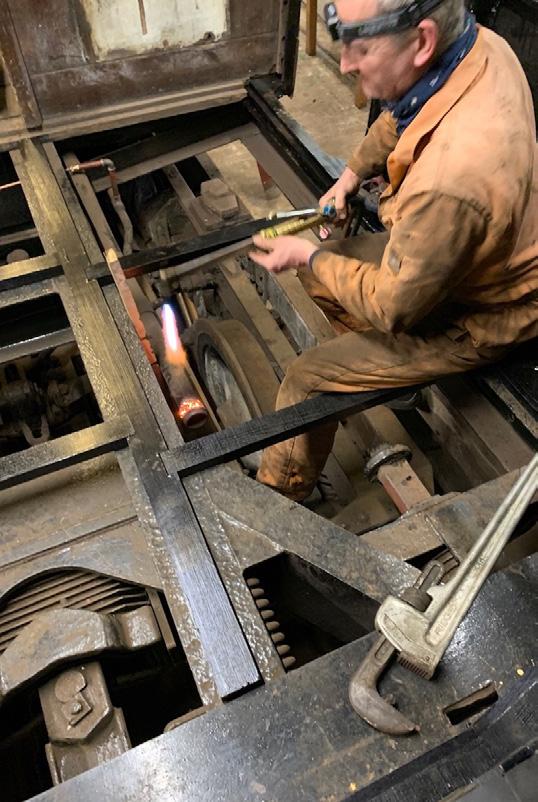

17 DFR Magazine Issue 67
Above: Barry works on one of the battery boxes.
Above Right: Andy warms pipework above the north bogie.
The window scissor inside a door on 5175.

34742 – Mark 1 BCK
The coach was moved into the Blueline Building where Ed and colleagues replaced the non-operational vacuum cylinder and Andy replaced steam heating pipework which had left passengers on the Santa Specials sat in the cold.
John and Tim started on the two windows that were allowing water ingress. Being left for so long has resulted in rot in the window frames, side panels, and seats.
New window frames and seals have been ordered and Keith has carefully made replacement side panels, whilst the seats are now in the process of being assessed.
The paint on the roof was de-laminating, it would appear that there has been a reaction between the primer and the first coat of paint resulting in it lifting off. The old paint has now been removed and the roof fully repainted.
4980 – Mark 1 TSO
Once the repairs to 34742 were completed and it was returned to the running set, 4980 was moved into the Blueline building to have the steam pipes replaced and various minor repairs or adjustments undertaken.
With the level of corrosion exhibited by this damaged section of steam pipe, along with the sizeable hole in the side, it is no small wonder that the steam heating had not been functioning very well! It is hoped that these types of repairs will continue allowing the whole train to be fully heated by the time Santa is back on-board next Christmas.
Above: The freshly repainted roof on 34742.
Below: A section of steam heat pipework from under 4980.

18 DFR Magazine Issue 67
Membership Matters
Membership Secretary Adam Williams, reports on our membership
Where are we?
We are currently at 1,345 members, our goal will to be maintain that if possible. It will fall due to non-renewals and current economic issues may make that it seem difficult. You may recall that I quoted George Eastman in Issue 65 in that “You have to spend money to make money”, well on that note – the Expression of Interest for the grant funding for Lydney Junction is now being written up. Even with the greenery growing (in the like tropical conditions), we are able to clear the growth without wrecking tools.
Have you got a spare £1,500,000 sat in your back pocket? Realistically that’s the figure that we need in order to make the development happen for a complete turn-key solution.
The grant that we are applying for requires a matched figure of 10% which includes monetising volunteer input. Just as a comparison, if we monetised the time spent using the RRV on clearing the site of vegetation and rubbish:
• The going rate for machine hire is around £65/hour
• The going rate for operator hire is around £35/hour
• The machine was used for over 115 hours
So, if we had hired in an RRV, and an 'RRV Operator' competent for operating it, we would have spent around £12,000, and that is just one person with one machine!
Throw in the fact the team was an average of six people and (without disrespect to them – they are well versed) of the other five, two were 'chainsaw operatives' and three were 'labourers'. With going rates of around £20/hour and £12/hour respectively, that equates to around £8,140, (and there was more work done when the RRV was switched off that we haven't even considered – such as tending fires, sorting, bagging materials, waiting for scrap lorries, etc). Anyway, it is a different way of thinking that we need to adopt, but with tongue in cheek, just £129,860 to go then?
Following the Great War poster ‘old adage’ that “One Volunteer is worth Ten Pressed Men”, what use is this if by one hand “all men are created equal” (a quote from the United States Declaration of Independence) but based on my explanation above they aren’t? Ponder that a while...
We are volunteers pursuing some form of happiness, and we do this because we live where we have the liberty to do what pleases us, within the law. Let's move on before I give every reader an existential crisis, but before we do... sign someone up, you don't know what they might achieve!
Electronic Magazines
We are now actively publishing our magazines via an eReader, so anyone wanting to only receive their magazine electronically should please get in touch!
Renewals, etc...
There are just a couple of key reminders, I’ll reiterate…
• Cash should only be used at Norchard, in person, so please do not send cash in the post!
• You can renew by Cheque, Postal Order, Standing Order or online via: http://bit.ly/DFRSociety-Renew
• If you are paying by Cheque or Postal Order or if you’re completing a Standing Order mandate, please:
1. Complete all of the details
2. Do not write 'blank' or post-dated cheques
• We cannot accept responsibility for renewals that go astray in the postal system, if you haven’t heard anything after 28 days – please get in touch.
Gift Aid
Around 60% of members are in our Gift Aid scheme, if you haven’t signed up for Gift Aid (and you’re eligible to do so) then please use the form that comes with this magazine.
Working Member’s Identity Cards
Volunteer? Don't have an Identity Card? Please supply an up-to-date digital passport style photo or even a ‘selfie’ providing that it is against a light-coloured background, along with the details of the department that you work in.
Privacy Statement & Data Protection
The DFRS holds personal information for the provision of goods/services, renewals of membership, distribution of formal documents, newsletters, appeals for financial support and volunteer labour. The DFRS complies with its obligations under the Data Protection Act and General Data Protection Regulations in relation to the keeping of, and provision of access to the registers of its members.
So, if you notify us of any change in address or circumstances, unless you instruct us to pass these changes on to other groups within the railway, we cannot share your personal data. This even applies when dealing with bereavements –it may seem callous but that is the nature of the regulation unfortunately, and we will be otherwise breaking the law.
So just because you have informed me (as the Membership Secretary for the Society) does not mean that I can inform, the DFLG, the DMU Group or even the Company Secretary… unless you specifically instruct me to do so!
Member's Discount Code
On normal running days members receive a 50% travel discounts, on the production of a valid membership card. If booking online, use the discount code DFRSMDX4892 when checking out, still bring your membership card mind!
19 DFR Magazine Issue 67
Hill Street Blues
Alex Davies reports on the largest infrastructure project that we have undertaken in recent times.
The one thing about Permanent Way that those of us who work on it know, is that it is anything but permanent. Rail wears out, sleepers fail, and track layouts change in line with the changing operational requirements of the railway.
The DFR's Permanent Way team has a list of ‘hot spot’ locations where potential failures could occur with disastrous results for the railway. High on that list until a few weeks ago was Lydney Town (Hill Street) level crossing.
The trackwork through the level crossing had last been replaced by volunteers in 1987 using check-railed 95lb bullhead rail, laid on wooden sleepers buried under tarmac.
A crossing of this type has a life expectancy of around twenty years, 2024 would have marked its 37th birthday...


With the track buried in tarmac there was no way to check the state of the sleepers without making test excavations etc. that would have required at least partial road closure.
All we could be certain of was that a failure of the track in the level crossing would have a significant impact on the railway and the road traffic in Lydney. If those test excavations had revealed problems, we would have had no choice but to close the line until the crossing was renewed.
It therefore seemed prudent to skip the investigation and simply go ahead with a planned renewal rather than have an emergency renewal that was thrust upon us.
Responsibility for maintaining the surface of a level crossing depends on precedent – does the railway cross the road or vice versa? In the case of the DFR’s five level crossings, three of them (Hill Street, Whitecroft and Parkend) are the railway’s responsibility as the railway was laid across existing roads, the other two (Lydney bypass and Harbour Road) are the responsibility of Gloucestershire County Council because roads were built over the existing railway.
Renewing the track through the crossing was initially considered by the board in late 2021. The original plan was to employ contractors to deliver a turnkey solution (i.e. the contractors do the entire job with DFR simply providing a scope of work) but it quickly became clear that the cost (in excess of £350,000) would be prohibitive.
Left: The old BR track being dug out during 1987.
Below Left: Rails being welded, with the road partially open.
Below: The then new track being backfilled with Tarmac.
(Photos: D. Payne)
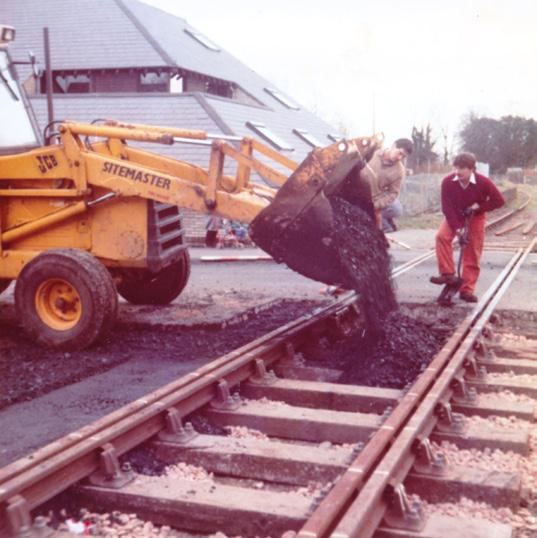
20 DFR Magazine Issue 67
There was also a question mark over the proposed technology to be used… The contractors favoured a Polysafe crossing, similar to those installed on the A48 Bypass and Harbour Road, and the most common type in use on the national network. The problem with the Polysafe system is that it requires frequent maintenance with associated costs. With this system, the road surface around the railway track consists of a number of concrete slabs mounted on rubber pads which sit on top of the concrete sleepers and allow the slabs to bounce slightly as traffic goes over them. Unfortunately, as regular users of the Bypass crossing may notice, the pads wear out and need to be replaced every few years to ensure the slabs don’t start rocking and, potentially, collapse into the track.
The high volume of traffic on Hill Street would have meant a frequent maintenance programme for a Polysafe crossing which would be extremely expensive and disruptive to traffic. Concurrently, Adam Williams had been doing research into alternative solutions for a level crossing at Travellers Rest under the auspices of the late Roger Phelps.
One alternative was a system that had been developed by the Dutch company Edilon)(Sedra since the original A48 Bypass level crossing was installed in the 1990s. This system draws on the experience of installing tramways in cities and uses large pre-cast concrete slabs in place of sleepers with the rails being laid in channels encapsulated in an epoxy compound, producing slab-track.
This system has no moving parts and thus has a much lower maintenance cost than the Polysafe system. For a cash strapped heritage railway, it was easy to see that, while initial installation costs may be higher, with an expected lifespan of 50 years or more, over its life-cycle the total cost of the Edilon)(Sedra system would be much lower.
Thus, in early 2022, we took the mad the decision to install the Edilon)(Sedra system in the Hill Street crossing and, to keep installation costs to a minimum, use volunteers and local contractors as far as possible. This decision wasn’t without precedent. Several Edilon)(Sedra crossings have been installed on heritage railways, most notably on the Kent and East Sussex railway at Rolvenden and Northiam, and on the Mid Norfolk Railway at Dereham (where the crossing actually sits under a flyover carrying the A47). We were fortunate in being able to draw on the expertise gained from these installations and, in particular, to have the advice and assistance of those involved in those works.
Six slabs were duly purchased and delivered to Norchard, starting the clock running to get the crossing replaced.The original target period for the renewal was February 2023 but, for a variety of reasons, this proved to be unrealistic, and the date was eventually put back to 2024...
As the design element advanced, we began to look at the long-term expectations for the railway and how the crossing renewal might affect them. You may have wondered why the track through The Hill Street level crossing was not central relative to the crossing gates. The answer is that the crossing was originally double track...
The double line was reduced to a single line by British Rail in the 1960s. That line ran close to the gates on the east side of the crossing and, in particular, to the gate post at the entrance to Thomas’s Yard (now SWM).
Looking to the future this alignment meant that the crossing gates could never be replaced with barriers as there was no space to install the barrier motor unit on that corner of the crossing. This was considered in the design for the new level crossing, with both the slabs and new track being installed slightly at an offset and at an angle from the alignment of the old Up Line.
The track on the north side of the crossing is now around 700mm (2 feet) further west than it was previously, allowing enough room to install the barrier motor should barriers ever be installed in the future. It should be noted that, at this time, the railway has no immediate plans to install barriers but allowing the small offset means that, should that be a future requirement, it can be done without needing to dig up the whole crossing again.
The realignment through the crossing also meant that the track needed to be realigned on both sides of the crossing. On the south side a small slew of around 300mm was required but on the north side the track was run out into a slight curve around 25 metres (80 feet) north of the crossing with the maximum slew being around 1 metre. This new ‘dog-leg’ can be seen when looking north from the crossing or the platform of Lydney Town station.
Among the many things considered during the design process was the weather and light conditions when the job was being executed. We knew that a full road closure would be required for the installation and the closure period would need to be kept to a minimum. We were also aware that, given the residential nature of the location, we wanted to avoid working through the night if we could.
As anyone who has ever done a turn as crossing keeper on the town crossing on a rainy day can attest, the surface drainage on Hill Street can, at best, be described as minimal with significant amounts of water running down the hill and into the track before finding its way into the track bed on the south side of the crossing.
Much as we would have liked to carry out the work during the railway’s closed season and, ideally, during the school half term in February, it was clear that the limited daylight and probability of bad weather would mean there was a high risk of overrunning on the road closure.
Instead, we took the difficult decision to close the southern half of the railway to traffic between Easter and the Early May Bank Holiday weekend. This gave us a window of almost 5 weeks to complete the work with a choice of one of two weekends in April, either the 13th/14th or 20th/21st where we could close off Hill Street entirely.
After discussions with the surfacing contractors and Gloucestershire County Council’s Streetworks team it was decided to keep Hill Street closed until Monday evening to allow for the surfacing work to be completed.
21 DFR Magazine Issue 67
Special arrangements were negotiated with SWM, the fire service, and the various businesses and residents who would be in the closure zone and in close proximity of the work and an application for the road closure from 6am on April 13th to 6pm on April 15th was granted in January. Thus, the scene was set for a complete severance of Lydney from a traffic point of view for the first time in living memory. 60 hours to get the job done – no pressure.
In late January we were treated to an unexpected side show when a truck delivering materials into SWM collided with and wiped out the crossing gate post on the northeast side of the crossing (next to the opticians). This didn’t directly affect the renewal work, but it had a minor benefit as the absence of the post meant we had one less obstacle to deal within the tightest part of the site.
Much of my time in February and March was taken up with engaging contractors, booking equipment, ordering materials, and liaising with various stakeholders. As the saying goes, you can’t please all of the people all of the time and there were always going to be a few people for whom a three-day closure of Hill Street would be calamity. All we could do was explain why it was necessary and promise that we would keep disruption to a minimum.
Months of careful planning ended and the notes and drawings on paper started to become reality on April 2nd with the removal of the crossing gates and the spear fencing separating the line from the access road to SWM.
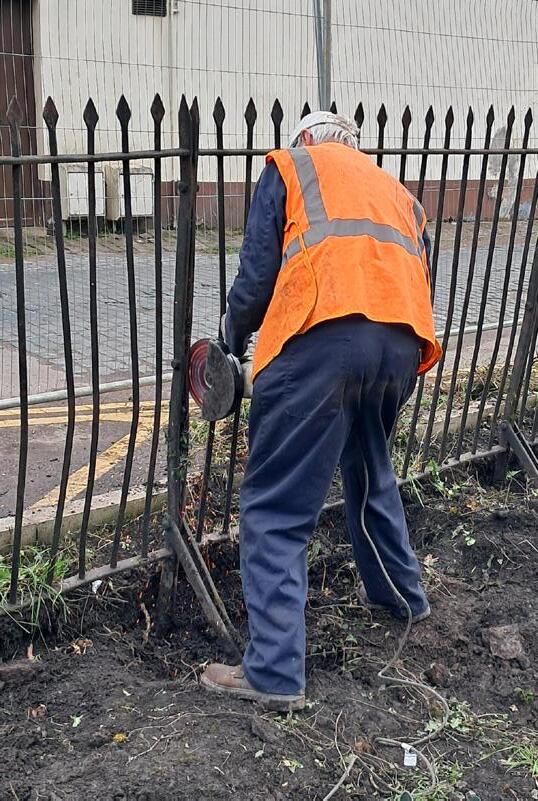
The old fencing needed to be removed to allow access to the site for materials and machinery.
Within a few days the fencing had been removed, the crossing gates had been taken to Bream for shot blasting and the first two panels of track north of the crossing had been removed. The reasons for removing the track panels were twofold. On the one hand as this was the point of maximum slew it was easier to remove and relay the track than to slew it across. On the other hand, removing the track significant increase the amount of working and storage space around the work-site.
Away from the work-site itself at Lydney Junction preparations began to assemble the two 90-foot rails that would run through the crossing. Rail comes in 60-foot lengths, so a rail was cut in half and the two halves welded to two other rails in order to give the 90-foot lengths required. These rails were then shot blasted and treated with a primer prior to being moved to the work site.
Surveys of the buried services under the crossing did raise a few concerns, there were a significant number of them... A large number of services is not unusual on a town centre street but, with plans to dig down to a depth of 1 metre meant we were going to have to have to contend with cables suspended in mid-air until they could be backfilled.
Below Left: Removing the old spear fencing. (R. Alpin)
Below: The 60-foot rail being cut in half. (A. Williams)
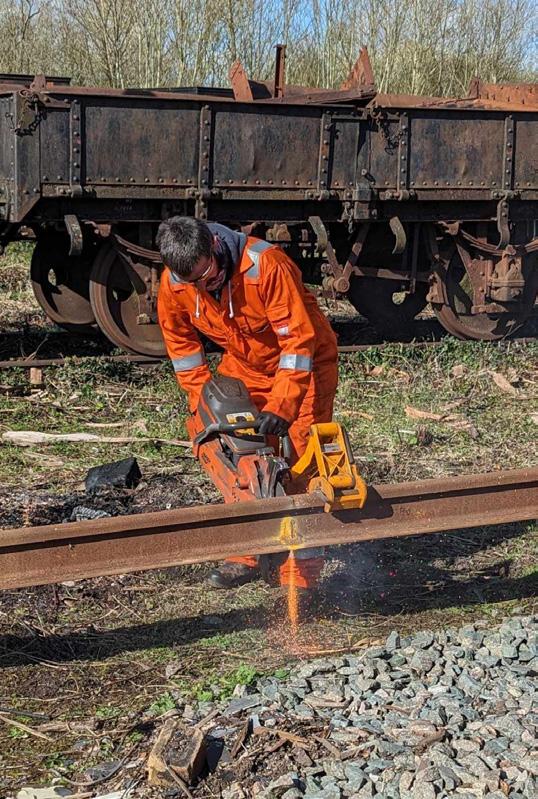
22 DFR Magazine Issue 67
This was the known unknown, as until you actually start digging you can’t be sure what you will find. Are the cables in ducts? Are pipes set in concrete? Are they perhaps made of other heritage materials that we don't want to find?
This sort of detailed information is rarely documented and even the exact location of the services is often quite different to that shown on the utility company diagrams.
In the run up to the work the DFR invested in sending five volunteers, including myself, on CAT scan training and also procured a state-of-the-art CAT scanner and generator.
Even with these new-found skills it was still prudent for us to engage a specialist company, Land Utility Group, to carry out a full site survey tying together the various lots of information we’d obtained from the utility companies.
We ensured that we carried out a test dig on the south side of the crossing, this was to locate a power cable that was thought to be quite close to the surface. In the event it turned out to be a lot deeper than we had expected but was still within the striking distance of the planned dig.
As the date of the dig approached, we became concerned that the number of volunteers, particularly specialist machine operators and experienced ground workers, might not be sufficient to carry out the precise work...
Below Right: Welding the 90-foot rails. (A. Rennie)
Below: The rails laid out ready for welding. (A. Williams)

This included the digging, backfilling and precise levelling required before the slabs could be installed. The decision was taken to engage two local contractors to assist the volunteers. SDG Groundworks came in to help with the dig and their 360 excavator with its ‘steel wrist’ attachment proved a useful asset supporting our RRV and the two 8-tonne machines we had hired from Maddocks in Coleford. CM Contracting supplied a larger team who stayed with us through the dig and backfilling until the slabs had been successfully installed on the Sunday afternoon.
As I ticked off the days leading up to April 13th, I also became somewhat obsessed with weather forecasts. Fortunately, the weather gods smiled on us, and forecast was for dry weather with some sun. With around 15 hours of ‘working daylight’ on each day we were confident that, barring anything completely unexpected, we could complete the work without needing to work into the night. None the less we had a lighting tower on standby.
I have never tackled a project of this complexity, so I am still amazed at the number of things that I had to deal with that were indirectly related to the work itself. Everything from hiring equipment and ordering materials, explaining plans to local residents and businesses, creating rosters, to organising food for the volunteer workforce.
One of the big concerns with the Hill Street crossing is the proximity of the Fire Station, but very early in the planning process we opened discussions with the fire service about the arrangements for them during the road closure...

23 DFR Magazine Issue 67
The main problem for the fire service was not getting the fire engines to the fires but actually getting the volunteer fire fighters to their station in the first place as many of them live on the east side of the railway and the fire station is on the west!
In the event a simple solution was agreed. Wildin’s accountants allowed us to cordon off six parking bays in their car park next to the town station specifically for use by fire fighters. A panel in the fence between the railway and the fire station was removed and some temporary steps cut into the bank. This enabled the fire fighters to park their cars and crossing the line away from the work site to access the fire station.
At 6am on the morning of Saturday, April 13th, the team from Chevron Traffic Management moved in to close the road and the work began. The first task was to extend the temporary fencing which, until then, had simply been preventing people from getting onto the railway.The Heras fencing had to be used to create a larger compound for the plant, machinery, and spoil trucks to operate in.
By 8am the contractors were on-site and the digging out had begun. Under clear skies the work progressed rather quickly, and the track was soon removed.Then the delicate task of digging around the buried services began. In the event most of the services were well protected and the ground very firm so a decision was made to reduce the dig depth. I can’t pretend that everything went smoothly, as at this point, we were a couple of hours behind schedule!

Breaking out the tarmac had taken longer than expected, as not had it only encapsulating the track but the hydraulic breaker attachment failing early on meant that alternative methods needed to be employed. Once a suitable depth had been reached, the buried services had been uncovered and a decision to stop digging helped get us back on track. With this going on, a separate team of volunteers walked the new rails the mile from Lydney Junction to the crossing. Each of the rails weighing over 1½ tonnes a piece were transported on four iron men pushed by eight people.
Ducts for the S&T and Telecoms cables were installed and encased in Postcrete, and we began to backfill. Further problems with some hired equipment failing to work led to a frantic dash by Craig Martin to fetch his pavement roller to help with the compaction work. More Postcrete and type 1 went into the hole and by 8pm the (by now somewhat diminished) team of volunteers and along with the boys from CM Contracting had got the base ready for the final levelling prior to the slabs being installed.
Continuing on Sunday morning, we encountered another issue when we found that the sand that we had planned to use for the final screed turned out to be the wrong type. Once again it was Postcrete to the rescue, this time mixed with other fine material. By the end of the weekend, we had used SWM’s entire stock of Postcrete, some 665 bags (13¼ tonnes), all of which was man handled by the team!
Below Left: Track lifted on the Norchard side. (A. Williams)
Below: Lydney Surfacing cut the tarmac. (A. Dickinson)

24 DFR Magazine Issue 67


25 DFR Magazine Issue 67
Above: Out with the old. (R. Marrows)
Below: Rails were torched to manageable sizes. (D. Johnson)
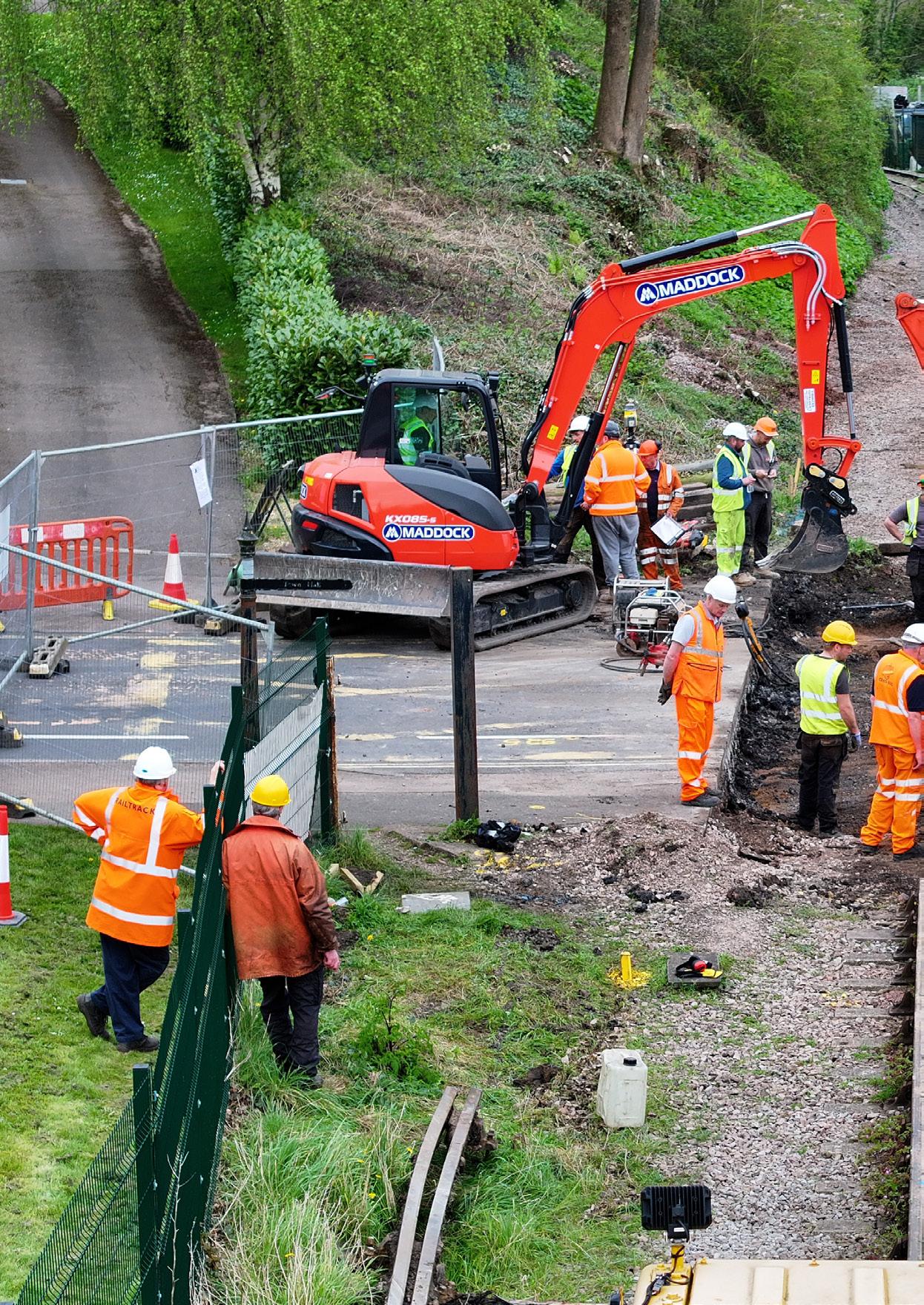
The carefully choreographed ballet of the excavators pauses momentarily so the depth of the trench and position of the buried services can be checked against the plans. (J. Ennis)



28 DFR Magazine Issue 67
Above: Next stop Bendalls! (K. Bailey)
Below: Three S&T ducts are laid in. (R. Marrows)
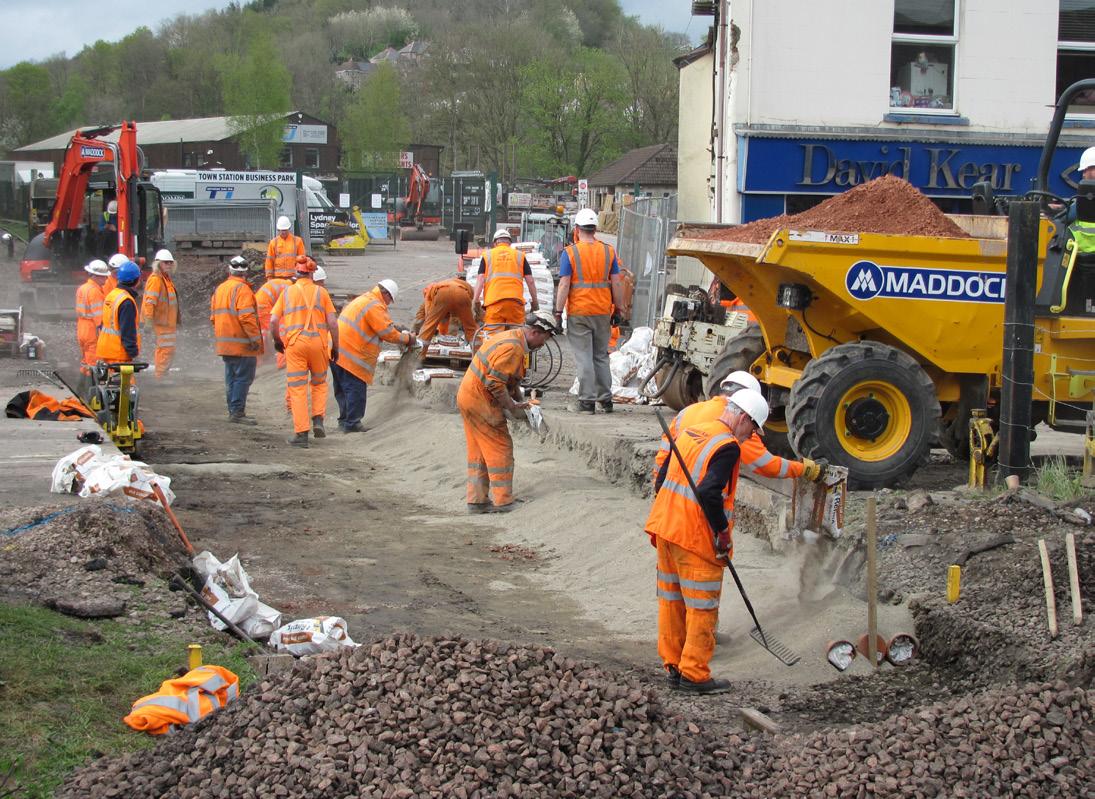

29 DFR Magazine Issue 67
Above: The ducts are covered in Postcrete. (R. Marrows)
Below: The bed is levelled ready for the slab track. (R. Alpin)
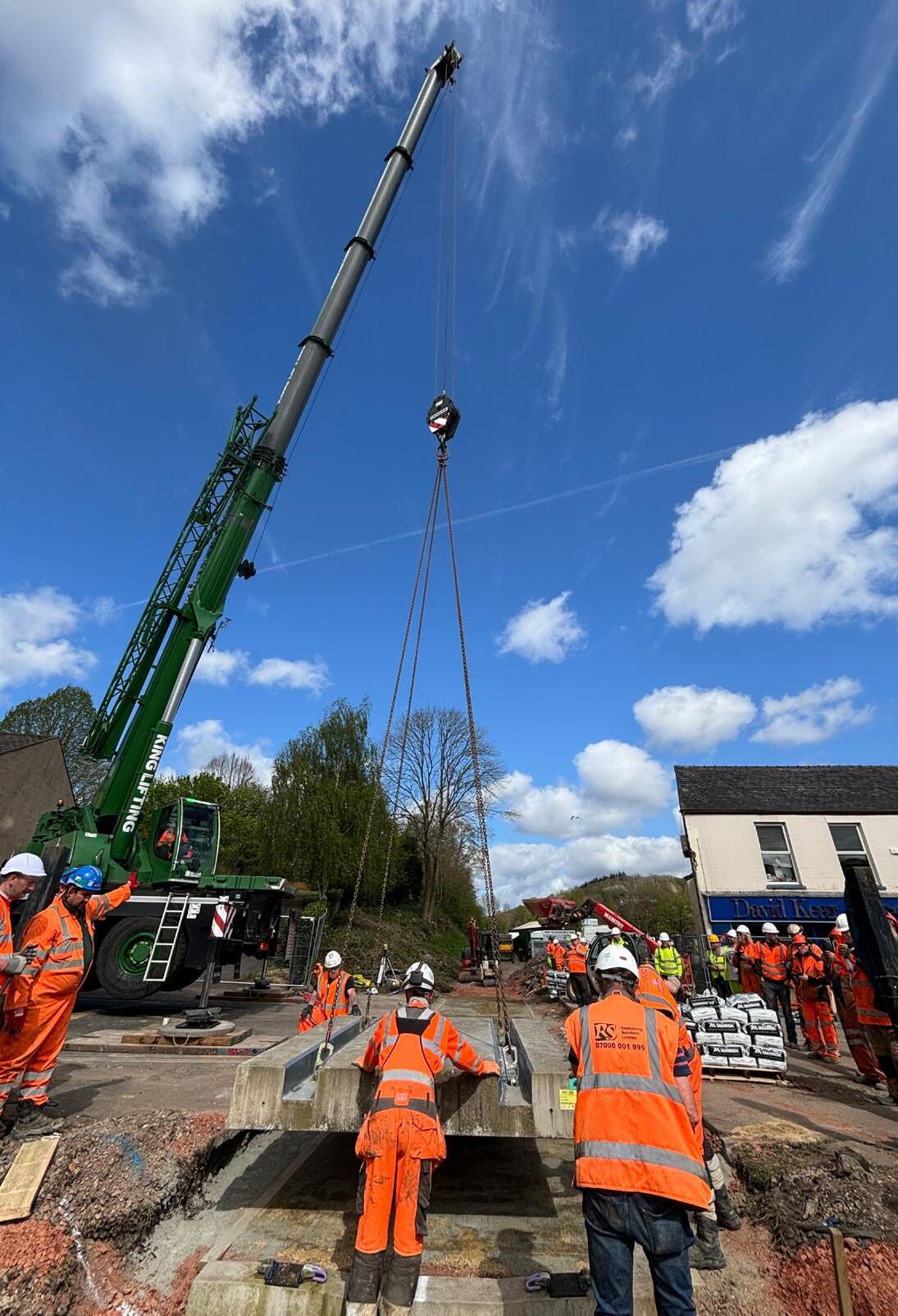
30 DFR Magazine Issue 67
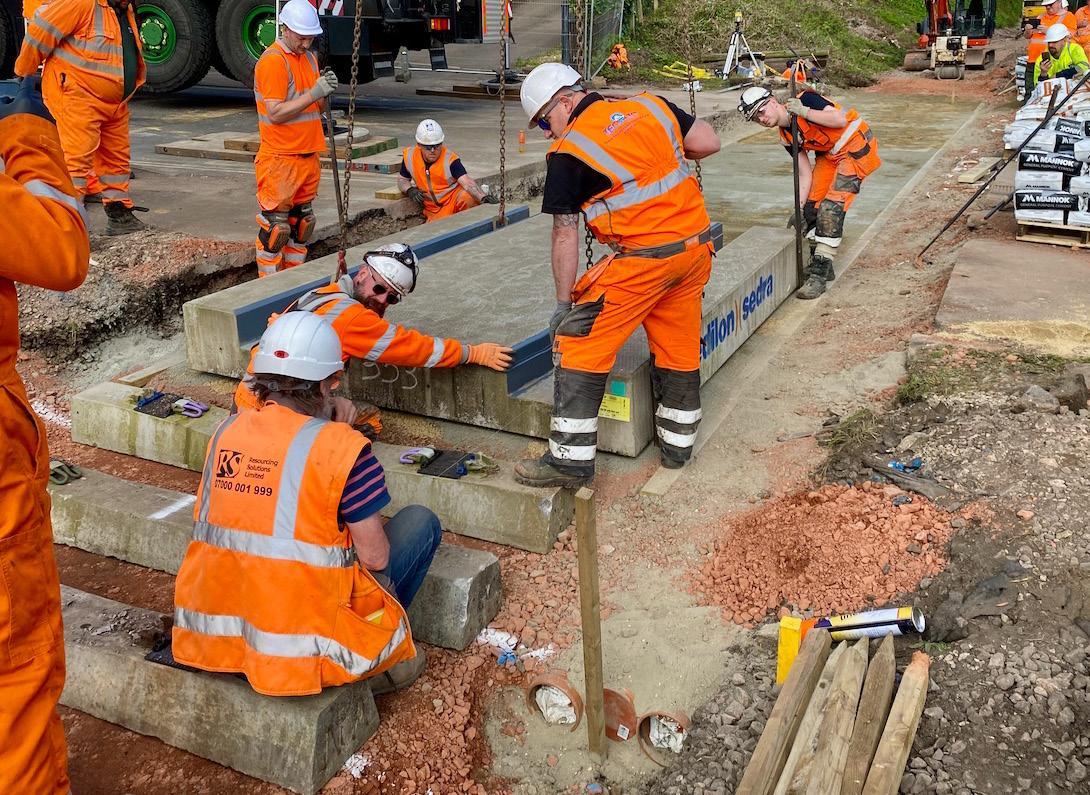

31 DFR Magazine Issue 67
Above: Positioning the first slab was critical. (D. Johnson)
Left: Carefully lifting in the first slab. (A. Williams)
Below: Postcrete... A concrete memory for all. (A. Davies)
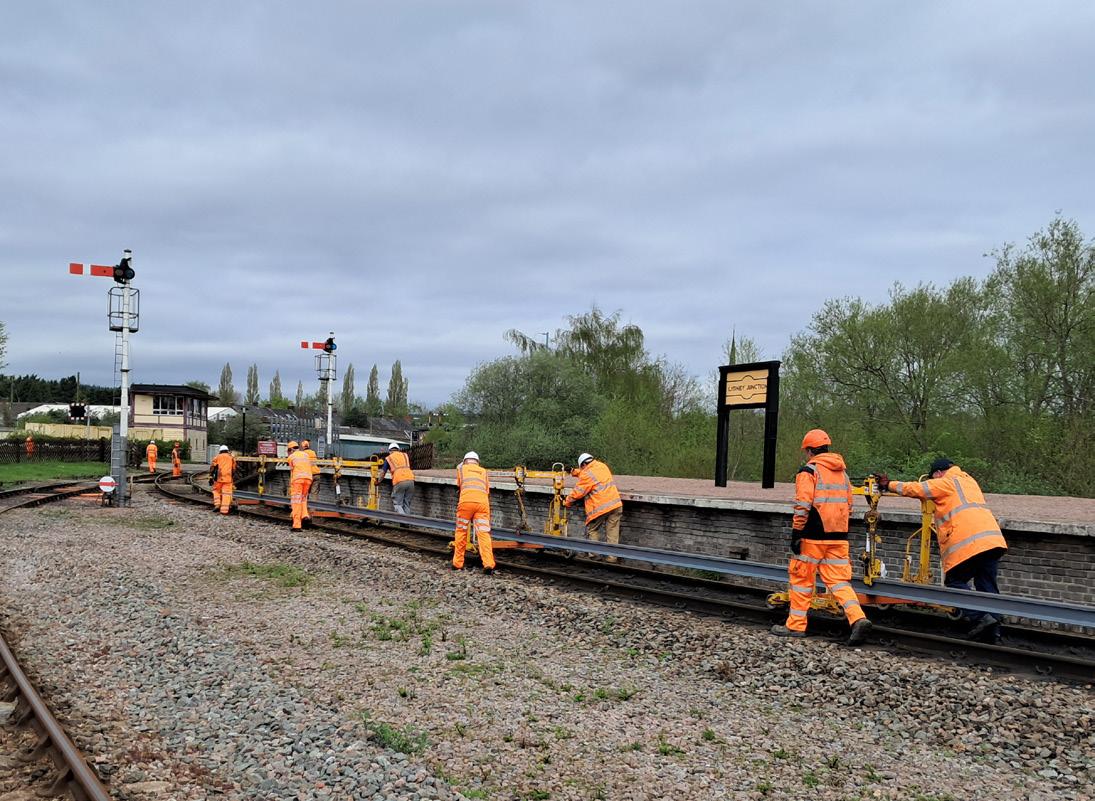
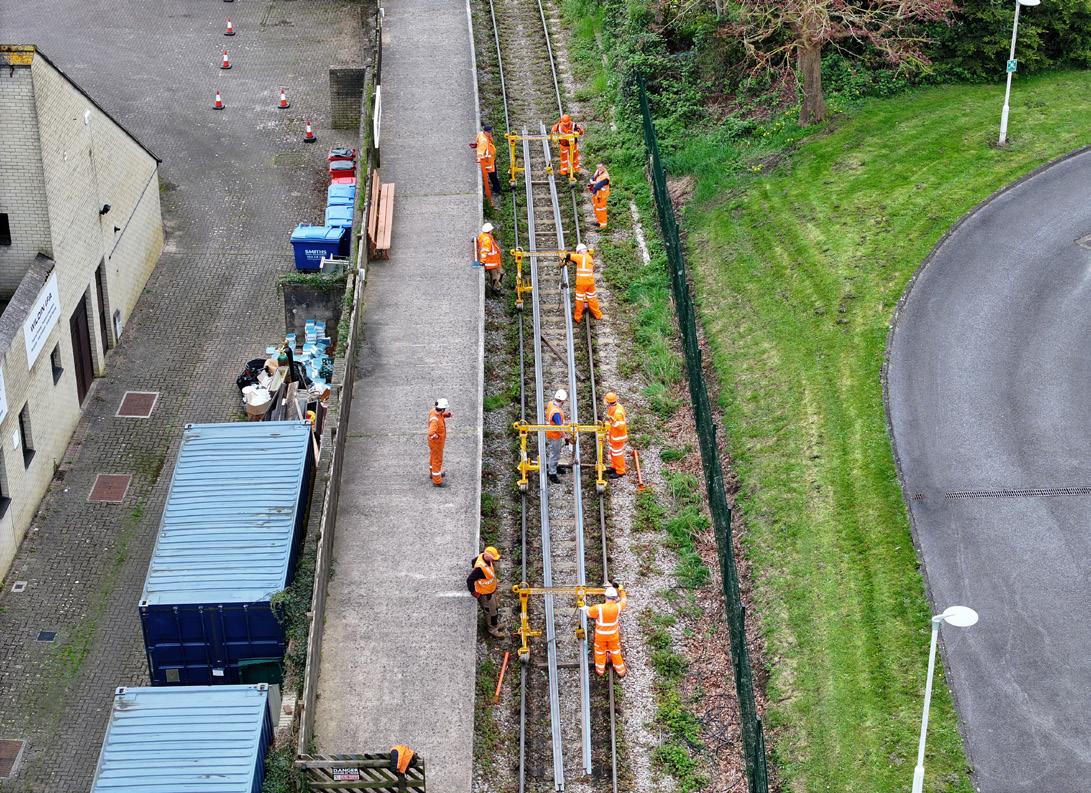
32 DFR Magazine Issue 67
Above: The rails now departing platform 2... (R. Alpin)
Below: ...then arriving at Lydney Town. (J. Ennis)


33 DFR Magazine Issue 67
Above: The rails being tandem lifted into place. (J. Ennis)
Below: Preparing to mix the Corkelast. (D. Johnson)

a
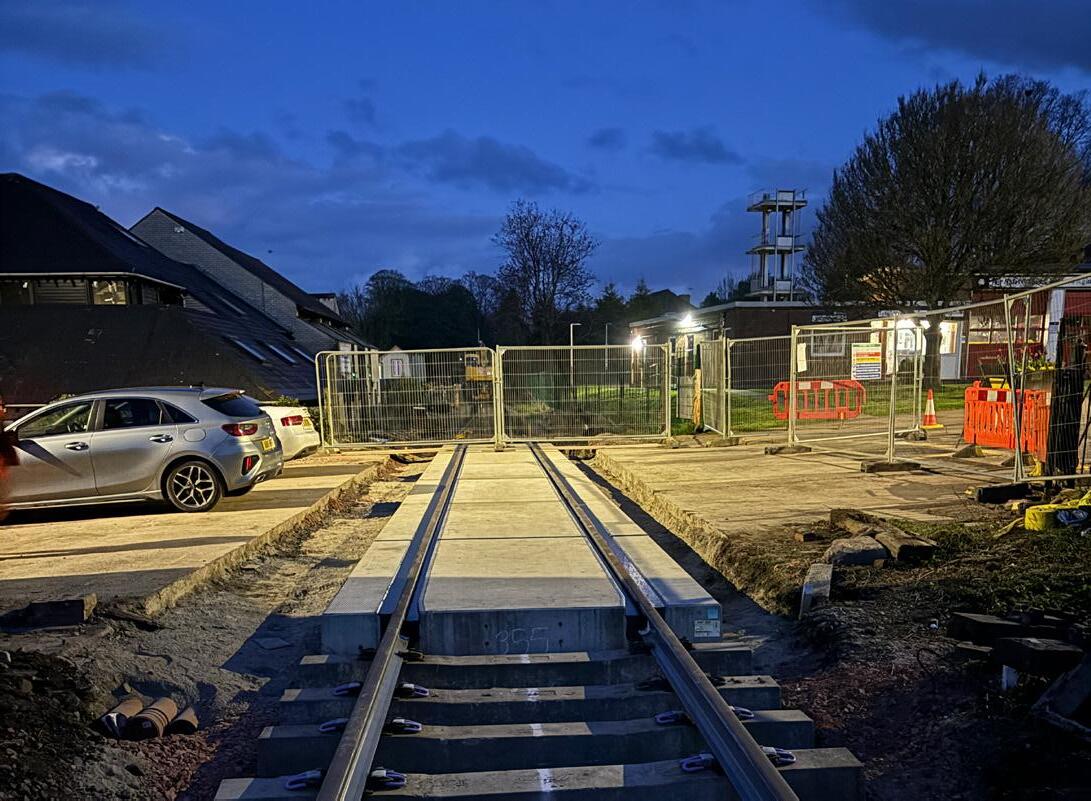
34 DFR Magazine Issue 67
Above: Pouring the first of many buckets! (K. Bailey)
Below: Night falls on
job well done... (A. Williams)


35 DFR Magazine Issue 67
Above: The tarmac base is spread and rolled. (A. Dickinson)
Below: All done bar the final layer of black-top. (A. Williams)
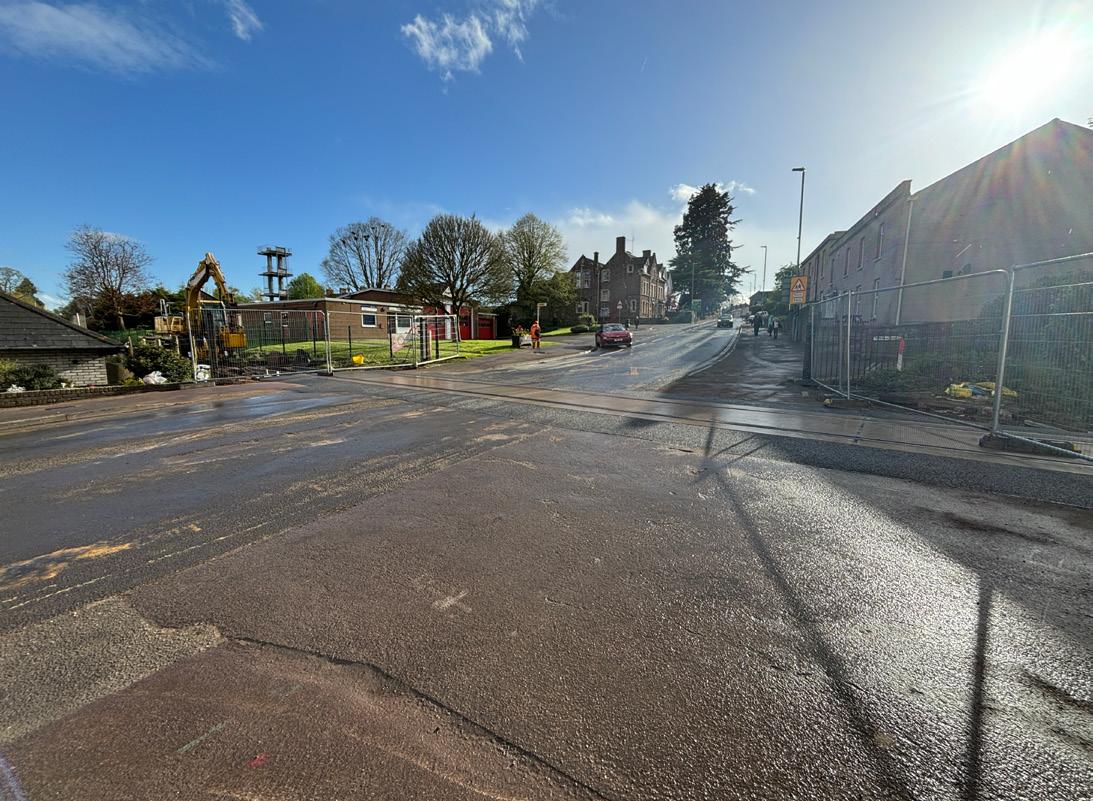

36 DFR Magazine Issue 67
Above: The road is opened ahead of time! (A. Williams)
Below: But there's still tidying up to be done. (A. Dickinson)
At 8am the team from King Lifting arrived and began setting up the crane while Tim and Tom Harrison started moving the slabs from Norchard to the fire station side of the crossing. Fortunately, we’d taken the decision to use two trucks to move the slabs rather than just the one. The original plan had been to bring the slabs to the east side of the crossing and lift them using the crane on the west side. However, this proved impractical as the lift/ reach combination would have required a larger crane.
Instead, the slabs were brought up alongside the crane by the trucks and lifted off onto the road ready for the crane to pick them up and lift into the works. With Hill Street closed and temporary traffic lights on the A48 the short journey from Norchard to the fire station actually took over half an hour each way.
Nonetheless, the slabs were all delivered and the precision work of placing them was complete by 1pm. Cue more Postcrete and cement to lock the slabs in place. The rails were then brought up and tandem lifted into the channels.
The Edilon)(Sedra team then set about completing the final levelling and positioning of the rails in the channels, before mixing and pouring the Corkelast® compound that fixes the rails in place and maintains the gauge. By 7pm the rails were glued in, and all that it remained for us to do was a quick tidy up of the site before calling it a day again.
Below Right: The final cuts before the last slew. (J. Leigh)
Our trusty team of security people (Mike and Sue from Spa Security) turned up for their third and final shift and regaled the few of us still on site with tales of the wild night life in Lydney and the exciting time they’d had with local revellers the night before.
Our luck with the weather finally ran out around 8am on Monday the 15th as we were in the process of doing the final preparations for the resurfacing of the road.
A heavy downpour saw the trench on the uphill side of the slabs fill with water to a depth of a couple inches or more.
Thankfully the rain didn’t last, and things quickly dried out. By mid afternoon we were looking at a completed installation watching the tarmac cool under sunny skies.
Our surfacing contractor said that the downpour could not have been timed better as it actually helped to speed the cooling process of the tarmac. At 5:30pm on Monday the team from Chevron arrived and we took the decision to reopen the road about 30 minutes ahead of schedule.
Now we had a nice new level crossing but, due to the realignment of the track, no connection to the railway on either side of it. With a train due in for a television filming sequence on April 29th it was time to get on with slewing and relaying the track to the north and south. On Tuesday 16th a team from KJG Price arrived and, working with our volunteers, the RRV, and the vintage Plasser HGR230 slewing machine (recently partially restored at the Vale of Berkeley Railway), set about reconnecting the line.
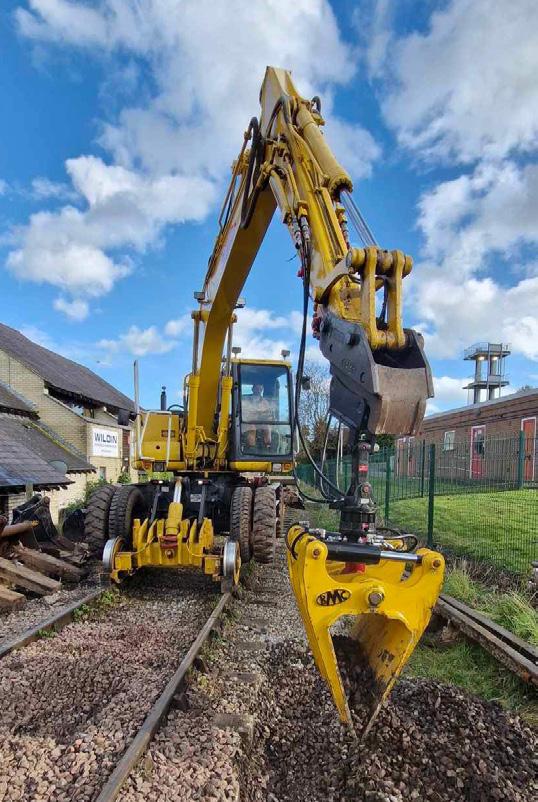
Below: The grab removes sleeper-end ballast. (A. Dickinson)
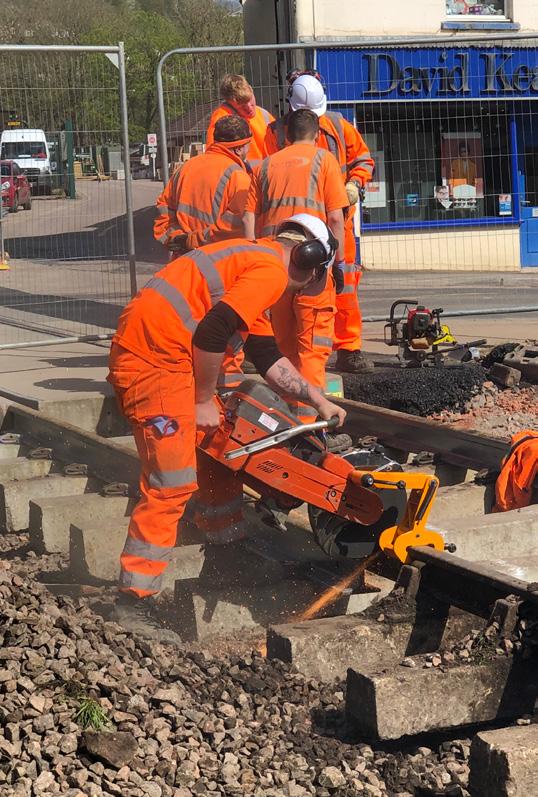
37 DFR Magazine Issue 67
By Thursday 18th the track had been slewed and reconnected and the ballasting and packing had begun.
Unfortunately, our PW130 RRV began to experience problems at the tail end of the road closure, thankfully Adam Williams was able to nurse it through the core of the works, but a new fault with a solenoid valve appeared and locked out the slew in one direction, so the work slowed down whilst a Quattro fitter was called to attend.
The team from KJG Price left on Friday 19th and the work became a volunteer only effort with members of the permanent way and S&T teams working to complete the work essential to allowing trains to run.
With the RRV out of action whilst it was being attended to, and the area to the south of the crossing still lacking ballast, on Wednesday 24th the decision was taken to have RBM Haulage use their grab loader truck to collect ballast from Lydney Junction and drop it into the track bed.
On Thursday 25th we packed the freshly dropped ballast and the first test train, consisting of D3937, a Loriot, and the shark, traversed the new crossing. However, excluding the RRV, this was not technically the first train over the crossing as, the day before, LSWR T9 30120 had passed over the crossing on the back of a low loader on its way to the Flour Mill for assessment ahead of a potential overhaul. The film unit’s coach was duly delivered on April 26th and filming took place on April 29th. The S&T team completed all the necessary connections for the signalling.

The crossing gates were returned, shot blasted and primed, and rehung on May 1st and the line was signed back into traffic with a 5mph speed restriction on May 2nd ready for the first passenger trains on May 4th. Finally, the new fencing along the access to SWM, including both a personnel and vehicle gate was completed on May 10th.
As I write this article in mid-May the bills are still rolling in and there are still some bits of outstanding work, but it looks like we are on track to bring the project in around 20% below the budgeted figure, a testament to all involved.
As I mentioned earlier, we tried to use local suppliers and contractors as far as possible for this work (even when some things didn't go quite as expected). Here is a brief list of the companies involved in our ‘buy local’ approach, and apologies if I’ve missed anyone:
BCJR Blasting, Bream – crossing gate repainting
Chevron Traffic Management, Newport – road closure
CM Contracting, Milkwall – excavations
Eagle plant, Monmouth – site welfare
Hales Hire, Drybrook – concrete breakers
Harrison Plant, Coleford – transport
King Lifting, Bristol – crane hire
KJG Price, Newport – track slewing and relaying
Below Left: The slewer transits the crossing. (R. Alpin)
Below: Tag-team ballasting and packing. (A. Williams)

38 DFR Magazine Issue 67
Land Utility Group, Tewkesbury – buried utilities survey
Lydney Surfacing, Lydney – road surfacing
Maddock Plant Hire, Coleford – diggers and dumpers
Mobile Media Blasting, Gloucester – rail shot blasting
Rail Support Services, Cwmbran – rail welding
Pirtek, Gloucester – hydraulic parts
Quattro Plant, Cwmbran – plant fitting
RBM Haulage, Alvington – spoil removal
SDG Groundworks Solutions, Minsterworth – excavations
Spa Security, Cheltenham – overnight site security
Speedy Hire, Gloucester – plate compactors and generator
Speedy Hire, Newport – iron men for rail transport
SWM, Lydney – construction materials
TEK Fencing, Lydney – fencing
Even the concrete track slabs supplied by Edilon)(Sedra were manufactured in the southwest, albeit by Cornish Concrete Products (located in the triangle between Truro, Falmouth and Redruth), while the flat-bottom rails came from a steel works in South Wales. These will need changing in 10-15 years due to the wear from road rather than rail traffic. That's easily done in a 1-day road closure.
Below Right: The first test train on April 25th. (A. Davies)
Below: Reconnected and packed, phew! (A. Williams)

We then have all of the secondary trading with the variety of independent and chain stores in the area, resulting from the sheer volume of volunteers and contractors being on site. I know that a few may have purchased shares in the local takeaway bakery chain – yes, you know who you are!
On behalf of the railway, I would like to thank all of the volunteers and contractors that were involved in the project. Your input no matter great, whether it was during the preparation, the critical weekend, or the aftermath – it all helped bring the project to a successful conclusion.
In particular we would like to thank:
Dave Hazeldine for his invaluable advice and experience throughout the planning and execution of the renewal.
Craig Martin of CM Contacting for rising to every challenge that arose which we threw at his team.
Austin James from SWM who was on hand through the weekend to meet our ever-changing demands for materials.
Peter Barber, Stuart Marshall and the Edilon)(Sedra team.
Finally, I would like to thank the people of Lydney, in particular the residents and businesses directly affected by the work, for their cooperation and understanding during the disruption which we tried to keep to a minimum. Anyway, that’s Lydney Town done, meaning it should be good for another 50 years. Next on the list is Whitecroft, and then Parkend. Also, perhaps Travellers Rest soon?

39 DFR Magazine Issue 67
Trolley Tales
Mike Keenoy has picked up the baton, and updates on the work being done on the Wickham Trolley.

Over a year ago I elected to complete the work required on our Wickham trolley to bring it back into service. This Wickham is a type 18A (Works No. 4254) PWM5643, also numbered DS3057 and was released from the factory in Ware (Hertfordshire) on 29/1/1947.
Up to this point all work and remediation had been carried out by the late Tom Coleman, this work included replacing the Ford 30hp Petrol V8 with a 4-cylinder Perkins P4 diesel engine. This new engine produces 55hp at 2400rpm.
At this point Tom had also chosen to redesign the bodywork, a great improvement on the original utilitarian structure. Tom carried out all this to a high standard. Having completed numerous administrative hurdles, and with the trolley being transferred from the Company into the ownership of the Society – I could actually start on the necessary works to finish it.
I first made steel frames for the engine cover and seats (courtesy of Honda Motorcycles, Gloucester). The engine cover was finished in aluminium, courtesy of S&T department utilising one of their old STOP signs. Various electrical components were donated by Adam Williams. All of these freebies helped keep the cost down.
Earlier in the year the RRV was used to carefully lift the trolley from its inaccessible siding onto the rails, from where it could be moved on to the end of DMU sidings.
The next task was to re-site the air filter housing and cooling system header tank to the engine bay purely for aesthetics, before carrying out various checks and running up the rebuilt engine. Next was to make a wiring loom to connect up the front and rear lights, horn, ignition, and all of the other controls.
Side curtains were measured and have been supplied by Attwoolls of Gloucester. The windows have been cut to size in acrylic and once finally trimmed will be fitted soon.
The brakes have had new cast iron shoes made and fitted that have been adjusted but will need to bed in and be done again. The brakes on this trolley were originally operated with just a hand lever. At some point, it has also gained a foot pedal! It might not remain.
At present the biggest problem is the roof. Having spent a number of years outside unprotected, the steel screws attaching the aluminium roof skin to hardwood slats of the structure have started to corrode and will need to be removed and replaced with stainless steel. Then we can paint it, probably green.
Until I discovered this Wickham in the Norchard sidings I didn’t even know they existed, let alone seen one. I have learnt a lot about them since then and hopefully soon you will be able to see it back in service albeit unpainted.
40 DFR Magazine Issue 67
Thanks to Chris Bull for the use of the DMU tools and kit.
On Tuesday 14th May, after the photographic charter, Adam Williams arranged an engineering possession for some running in trials, this was the first opportunity we’ve had to stretch its legs. We did have to wait for the charter to return, but that gave the opportunity to run back and forth along the loop and check that we could actually stop!
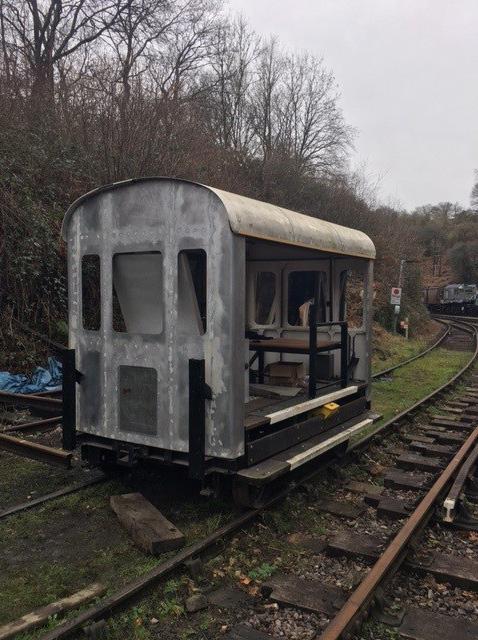

After a good run from Norchard to Parkend and back via Lydney Town, the brakes were starting to bed in well. The foot pedal worked quite well and will stay for ease of operation. There were a couple of leaks – of both coolant and oil that will need further attention, but it works!

Below Right: New cast-iron brake blocks after fitting.
Below Left: The seats and engine bay are all fitted up. (Photos: Mike Keenoy)

41 DFR Magazine Issue 67
Above: The fabricated engine bay, steel clad in aluminium. Left: The Wickham after being lifted over by the RRV.
Opposite page: The Wickham rests in the Down Platform at Parkend after an almost non-stop run from Middle Forge. (A. Williams)
Old Relics II
Jon Barry of the Wagoneers Group discusses DFR wagon conundrums in the second part of his article

Following on from Part 1 in Issue 65, where I covered the MR 3-plank open wagon at Parkend, I am indulging my growing interest in early railway wagons, typically dating from the 1840s to the 1920s. This time, I am looking at the timber chassis from a tank wagon that resides on a short bit of track south of Tufts Bridge. The MR 3-plank and this wagon are both of a similar vintage, and both have grease axle boxes, but that really is where the similarities end.
Sadly, we won't know this wagon’s story. However, it was possible to draw conclusions as to its history from the remains.What is certain is that it was a Class B tank wagon with a cylindrical tank. Pairs of diagonal fixings near the middle of the sole-bars on each side, for the (cut-off) stay rods that would have braced the end stanchions, are the give-away. There are also brackets in the draw-bar spring cradle, in the centre of the chassis, meaning the tank had a bottom discharge pipe below the frames.
The conclusions which follow are conjecture based on discussions with a few truly knowledgeable people and based on my own observations and measurements.
1. Cargo
It is unlikely to have been a chemical tank, as these would normally discharge above the frames. Also, they normally had smaller diameter tanks, but see below regarding the tank length and diameter.This leaves us with non-flammable petroleum products or water, as Class A products were not permitted on timber framed wagons.
2.
Tank diameter
Resting across the wagon, on the brake-gear, are two long narrow plates with rusted screws in them and a pair of larger holes at each end. It was initially suggested to me that these plates did not belong to this wagon.
However, further examination has revealed that the holes and screws in the plates line up exactly with holes in the underside of the chassis’ two cross-members and solebars, exactly above where they are resting. So, when the wood rotted, the plates simply fell to where they are currently. My guess is that the holes which go up through the cross-members were for the straps which would have gone over the tank.
So, the spacing of the holes should equate to the diameter of the tank, this being 5ft 4½in. My guess is also that the holes going up through the sole-bars would have served to hold fixings for the transverse wooden saddles that the tank rested on. There is no evidence to suggest the tank was cradle-mounted (i.e., two longitudinal beams under the tank), so it is safe to assume it was saddle-mounted.
3. Tank length
This is where much “calculated guesswork” comes in! Based on the angle of those cut-off stay rod fixings, it should be possible to calculate the height of the crossheads (i.e., the high cross pieces at the tops of the end stanchions which hold the tank in position).
Normally (except for chemical tanks) these would be the mid height of the tank, i.e., half its diameter, plus the height of the bottom of the tank above the chassis. So, my idea was to measure the angle of the fixings (difference in height, and length), and extrapolate out to the full length of the chassis.
Not surprisingly, all the angles varied a little, but taking an average coincided closely with two of the calculations. So, assuming that the tank was the full length, the crosshead would have been about 15in above mid height, i.e., 50 inches instead of 35in, and this magnitude of difference is more than could be explained by extrapolation errors.
42 DFR Magazine Issue 67
If they had been at mid height, then the tank would have had a length of 10ft (assuming a diameter of 5ft 4½in is accurate), which would be noticeably short for a chassis measuring 15ft 6in. Some tankers did have high crossheads, a few, and this would appear to have been one such. 4. Builder and owner
No evidence remains as to who built the wagon, or for whom it was built. I gather that Pete Mason bought it from Wagon Repairs Ltd in Gloucester, quite some time ago.
Playing the odds would dictate that it was built either by Charles Roberts (CR) or Midland Railway Carriage & Wagon (MRCW, unrelated to the Midland Railway itself), for Shell or one of its predecessors, and this has been suggested to me as the most likely scenario. However, there are bolt fixings on the sole-bars, offset from centre, spaced 18in apart, suggesting a long plate which would be unlike any Shell or SMBP plate I have yet come across.
The wheels add to the conundrum. One set is by MRCW, whereas the other by CR. They are beautifully cast, and incorporate the maker’s name, and a year: 1899 for the CR set and 1902 for the MRCW set. One wheel-set broke and was replaced, which might indicate CR as the builder.
Possibly both wheel-sets broke at various times, so the wagon pre-dates 1899.It was not unusual for wheel-sets to break in the 1800s (due to inferior grades of steel and iron being used in the manufacture) and was one of the main causes of accidents. A bad accident in 1885 was a driver for the Railway Clearing House (RCH) standards.

The axle boxes are different again. One set is Wagon Repairs Ltd (clearly replacements). The other set is FT Wright Ltd (based in Bagthorpe, Nottingham), which is very unusual, but they were known as a repair centre as much as a wagon builder. Both sets are, however, grease axle boxes, so the wagon was never upgraded to oil axle boxes. This feeds into a subsidiary conundrum regarding RCH requirements for the rebuilding of wagons.
There is a tantalising remnant of the RCH register plate, required on all Private Owner wagons. All that is left is a small part of one end of one plate. Not enough to give us any details of who registered it, or its wagon number, or its year of registration. Those details would have been stamped into the sole-bar underneath the RCH plate, but the surface has weathered to such an extent as to obliterate any such markings. In fact, there are no visible markings or stamps on any of the frame timbers or ironwork (other than buffers, wheels, and axle boxes), although that was required by the RCH.
5. Tank fixings
The design of tank wagons has evolved since the first ones built in the 1800s. I gather that 1865 is the first one recorded, built at Gloucester. The earliest ones had “D” shaped tanks (flat bottom, semi-circular top); later rectangular tanks became common, until cylindrical tanks took over. We know this wagon had the latter, because of the remnants of those diagonal tie rods that I have found.
Below Left: A Charles Roberts wheel-set.
Below Right: A Midland Railway Carriage & Wagon wheel-set.

43 DFR Magazine Issue 67
However, these were not adequate to fully hold the tanks in place, and all similar small tankers also had straps over the tank as well as tie ropes around the manhole. With this wagon, we have evidence of the straps, but not of any tie ropes. I spent quite a lot of time hunting for evidence of tie rope fixings thinking they must have been there, and I am certain there were not any. However, unlike other types of wagons, the RCH were happy to be flexible on the tank fixings, if they did the job of securely holding the tank in place.
6. RCH rebuilding of wagons
Early wagons were built to a wide variety of designs. Many didn't have sprung buffers, or even brakes! It is quite a complicated subject on its own, but the RCH and Board of Trade introduced rules on the Reconstruction, Conversion and Rebuilding of wagons not conforming to the required standards. There are fixing holes on the sole-bars of this wagon, spaced at 3.75in which coincides with the spacing for “Rebuilt” plates. There is no way of knowing what rebuilding was done and might have just been the addition of a brake set if (as is likely) it only had brakes on one side. So, there it is: a conundrum from start to end. The timbers are crumbling, but I have measured every part of it, and it conforms to known RCH standards. If anyone has any thoughts on anything in this article, or has some information to add, I would be delighted to hear from you!
Once again, thanks to the Midland Railway Study Centre and the Historical Model Railway Society for generously giving their time and expertise in answering my questions.



Above:
Below Left: The Wagons Repairs Ltd axle-box.
Below Right: The FT Wright Ltd axle-box.

44 DFR Magazine Issue 67
Top: The cut-off diagonal stay-rod for the tank.
The broken registration plate on the frames.
DFDA Curtain Call
Bryn Thomas and Luke Wayman give a closing statement about the Dean Forest Diesel Association.

Our last report was in early June 2023, detailing the progress with 08238 and the engine rebuild e.g. pistons being lowered back into the new liners. However, it didn’t appear upon publication in March 2024, due in no small part to the change of circumstances that had completely overtaken the diesel depot in the time since it was written.
Many regulars to the Railway (and those who access the Official Dean Forest Railway Society Facebook group), will know the Diesel Department based down at Lydney Junction was dissolved during early 2024. The winding-up process more or less coincided with the hiatus of the DFR magazine, such was the timing.
Why the folding of the diesel group down at the Junction?
On reflection, a number of factors had played their part in the demise of the depot which had been based there for some 25 years or so in one form or another. In no particular order of impact, some of the issues included:
• Increasing difficulties with the facilities (e.g. life-expired ‘temporary’ buildings and the deteriorating coverings)
• Priorities with aging family members living at a distance
• Change in career direction and location, having spent over 20 years in one place with limited options for progression (for one of the full-time team especially).
The two sidings behind Lydney Junction Signal Box were cleared of the temporary buildings, rolling stock, storage containers, JCB telehandler and spares over a few months, e.g. 08238 departed for pastures new at the NYMR in early January, where its overhaul will be completed. Under the care of new custodians, 31210 and 31235 left in early February for the Great Central (North) at Ruddington. The GUV (M86898 - tools and spares storage), and former Margam breakdown coach (ADB975485) were dispatched
to a new home down south around mid-February. The last vehicle to leave was the welfare wagon (ex-motorcar ferry van ADB889014) on 29th February, taken by 08769 and moved slowly down the line to Norchard. Purchased by the DFR Company, it is currently subject to fabric repairs, repainting, and an internal refit to better suit its next role as the new mess van for the steam crews.
Meanwhile, still-resident 08769 (minus its Gladys nameplates) has changed ownership and is now with Valley Rail Preservation.The DFR has signed a long-term contract with the new owners, so the provision of a locomotive has been secured for the foreseeable future.
So, ‘769 is in good hands, slotting in with an existing fleet of the type (the new owners have 5 Class 08/09 locomotives on their books) and the experience this brings.
While the railway was severed at Lydney Town crossing in April, the opportunity was taken by the new owners to undertake some scheduled maintenance, including new brake blocks, oil filter changes, vacuum filter cleaning, tyre wear measurements, unblocking the radiator water level gauge, the fitting of an engine hours counter onto the right-hand side of the driver's desk and electric oil priming pump, complete with red button on the left-hand side. The latter modification being popular with the person usually tasked with the manual pump priming before startup. Such simple changes all work towards making Working at Height just that little bit safer (safety step 1 – eliminate the need before trying to mitigate against issues arising).
In closing, it just remains for us to tender our thanks to all of those who provided valuable help and support over the years, and also for their patience. Typically, when fitting in with and around our own priorities with regards loco stabling and maintenance schedules, etc.
45 DFR Magazine Issue 67
Beneath your wheels
Alex Davies turns his attention away from large projects to focus on our regular maintenance works.
While the town crossing renewal work has dominated the Permanent Way team’s activities for the past few months it is not the only thing that we’ve been up to. With no major closed season project things were undoubtedly quieter than usual but there was still plenty to do.
The extremely wet conditions in February (a timely reminder of why we chose to do the town crossing in April instead) highlighted weaknesses in our drainage, particularly between Norchard and Whitecroft, and time was spent clearing blocked ditches etc. Time was also spent repairing the damaged hand point on the east loop and investigating issues with the Whitecroft siding point.
In February S&T work at Lydney Junction presented a rare opportunity for us to pack joints in the track on either side of the Harbour Road crossing. The density of point rodding and signal wires crossing the line outside the junction signal box normally means that we cannot get our hand tampers and stone blowing equipment near the joints but with much of the S&T paraphernalia removed we had the first clear shot at some of these joints in 20 years or more. Stone blowing was the order of the day because, away from the crossing, the ballast is quite shallow.
With the end of the financial year approaching, we started investing in some new equipment. One thing we have been lacking in the past is a sleeper drill for drilling wooden sleepers. Our drilling has always been done using impact wrenches – the equivalent of drilling holes with hammers. The Society came forward with an offer to cover the cost of a new Cembre rail drill. Shortly after the order was placed our friends at LB Plant Equipment also contacted me with an offer of a refurbished sleeper drill and rail drill at a fraction of the new cost. With enough money still in my departmental pot I took the decision to purchase both, meaning we now have two sleeper drills and two rail drills. I have also been talking to them about trading in our old Cembre impact wrench for a refurbished Master 35. This will give us three identically wrenches.
Our trusty iron men, donated by Universal Services several years ago, have been experiencing problems as the traverser gear boxes are worn out. I contacted HPC Gears to get some new gear boxes made up. These are now being fitted in our workshop. At the same time, I requested funding for a new set of Permaquip iron men and the company granted the funds for the purchase which has just arrived. Meanwhile LB Plant Equipment have come though again with a refurbished set of Permaquip iron men so we will soon have three sets of these useful tools.
We have also embarked on a programme of training our team. Along with the S&T team, we now have five people qualified to operate Cat and Genny equipment to assist with the location buried services along the railway.
We are also putting a number of people through 360 training with the final aim of having more RRV operators qualified who can come out on our working parties.
With the town crossing behind us we are now looking at a number of projects that will take us through until next year. High on the agenda is a remodelling of the area around the Geismar trolley hut on the high level at Norchard.
The aim is to tidy up the area and make it easier to get equipment on and off track as well as providing a place to store the Plasser slewer. Looking ahead to the autumn we are planning to replace various point timbers in the point work at Lydney Junction. Beyond that, in the longer closed season between the New Year and the start of the 2025/26 season we will be looking to replace sleepers between Whitecroft and Parkend. Various items of drainage work are being planned for the same time that the track is out at these locations, as well as other essential maintenance. We’re always on the lookout for new volunteers, and you don’t have to be out in all weathers or in the middle of the week to work with our gang.

46 DFR Magazine Issue 67
Above: Packing at Lydney Junction. (C. Kyte)
We are looking for mechanically minded people to help our ‘back office’ team repairing and refurbishing tools and materials. We urgently need to refurbish some hand point lever mechanisms so that we can replace failing ones in the yard at Norchard and elsewhere. We also have a large number of petrol engine tools, from simple generators and impact wrenches up to the Geismar motorised trolley, that would benefit from servicing by a capable mechanic. We are also looking for people who can help sort and catalogue the various permanent way ‘assets’ that the railway has. In the early days of the DFR we, like most infant heritage railways, acquired any materials that we could from the various railways and engineering firms that were closing down at the time. Many materials were simply stored on line side in case they were ever needed. Now, as a more mature railway, we have a much clearer idea of what we will and will not need going forward.
As noted in Issue 66 with Lydney Junction, a team are progressively tidying up the railway. Materials are being recovered back to designated locations in Lydney Yard. Once there they need to be sorted into items we want to keep, items that may be of use to other railways and museums and items that should be weighed in for scrap. This is the sort of activity that could be easily done on any sunny weekend days during the summer.
If you think you could help us with any of these tasks, please do get in touch via volunteering@deanforestrailway.co.uk

Garden of Remembrance
In the magazine Issue 65, Gill Christopher relates the opening of the Memorial Garden (Norchard in Bloom). There is a nice photograph of Memorial Board. Wearing my Museum cap on as well as Chaplain, I am aware that behind the Museum Garden at the end of Platform 1 on the wall of the building used by the Lineside team and as the Permanent Way store there are three plaques in remembrance of former Volunteers of the DFR. I wonder now that we have a dedicated area of remembrance whether these plaques should move to the new Garden?
But there may be reasons as to why they are where they are. This note is to ask whether anyone can tell us the history and reasons why they were put there.
If there were particular reasons then they should remain there but if it was only because there was a space of brick wall available then I suggest they be carefully moved, refurbished as necessary, and installed in the new Garden of Remembrance. The names are as follows:
• Derek Gatcliffe 2005
• Rex Banthorpe 2013
• John Brown 2014
There is no reason why all memorials should be in the same place, one to Roger Phelps, for example is in the Parkend Signal Box by reason of his particular contribution to the DFR in that area. But other than such reasons the new Garden is a lovely place for remembrance.
If anyone knows of any reasons for particular association with where they are at present or of relatives or friends who might know could they please e-mail or contact either myself or Gill Christopher.

47 DFR Magazine Issue 67
Above: The new Iron Men at Norchard. (R. Alpin)
Christopher Hill follows up on the opening of the Memorial Garden at Norchard
Letters to the Editors
After the publication of Issue 66, our mailbox was bursting at the seams, so if you wrote in – thank you!
Dear Sirs,
In Issue 62 of the DFR Magazine under "Letters to the Editor" a letter from G. Young of Bacup, Lancashire requested information on the former Rawtenstall Corporation's double decker bus registration number XTJ9 39D a Leyland PD3 which had been exhibited at the DFR's Rally on 20 October 1996 at Norchard.
This bus was later exported to Australia for a tourist company travelling overland to Singapore and shipped to Darwin in the Northern Territories. After a short spell in that area the double decker made some long journeys across Australia until being traced by Ian Lynas to South Greenough, some 24kms north of Dongara and 41 kms south of Geraldton in Western Australia
In some photographs taken by Ian Lynas in August 2019 we noticed to our surprise that the bus still carries a Dean Forest Railway rally plaque issued to every vehicle which was exhibited at Norchard on 20 October 1996
Now we wonder... Is this the furthest distance from Norchard that any exhibit of any DFR rally day has travelled with its rally plaque still proudly affixed recalling the day that it was exhibited at Norchard?
Mr. J. & Mr. S. White (592 & 610), Yatton
Dear Sirs,
Many thanks for the latest magazine (Issue 66). Very informative and interesting, certainly sets out the plan for the next few years very clearly. As ever, produced to a high standard. I would be content to no longer receive the printed copy, instead happily consuming the digital version. Mr. D. Clowes (5044), Barnstaple
Dear Sirs,
I've just finished reading Issue 66 of the DFR Magazine, what a joy it was as well, great images supporting some wonderfully informative writing, I really enjoyed it from cover to cover, well done to the whole team!
Mr. S. Warr (5232), Porthcawl
Responses:
Thank you all, and what a brilliant follow up to Mr.Young's letter. A slight piece of trivia from me – our coaches will complete an equivalent 8900-mile journey (the distance as the crow flies from Norchard to South Greenough in two operating seasons). Adam Williams
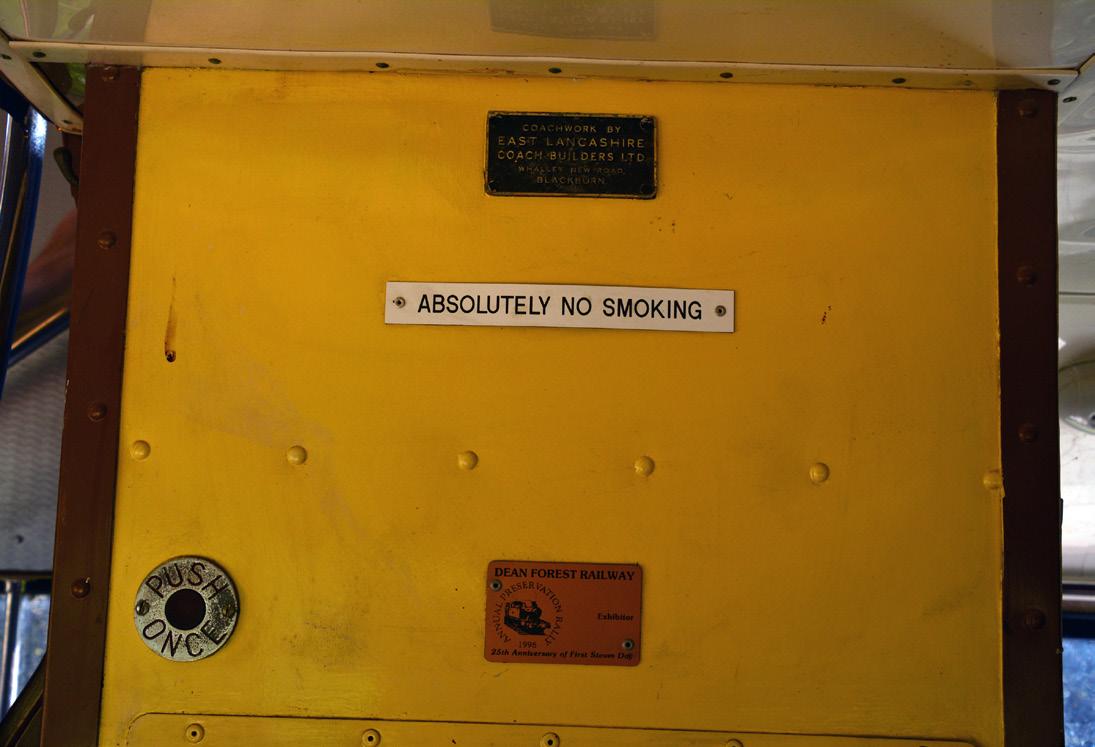
48 DFR Magazine Issue 67

Opposite
(Photos: I. Lynas)

49 DFR Magazine Issue 67
Above and Below: The former Rawtenstall Corporation Leyland PD3 double decker XTJ9 39D found in South Greenough, Western Australia. North of Perth (390kms) but south of familiar names... Carnarvon (510kms) and Exmouth (870kms).
Page: The Dean Forest Railway exhibitors badge fixed to the interior panelling on the upper deck.
Dear Sirs,
Adam Dickinson’s article in the last magazine was very informative and it is reassuring the railway has a clear set of objectives. If I may, can I put forward some observations?
Aim 3: On train catering. I felt it a shame when the Buffet coach was taken out of service. We promote a Cream Tea but served in its present form, if I were a visitor I would feel it was a poor experience. Collected from the cafe and with a stone cold cup of tea by the time I get to sit down on the train! Served as it used to be, at my seat with fresh tea and top ups, that is an experience. Additional revenue could be achieved by enhancing to a full Afternoon Tea served in the same way. I experienced this on the Jacobite train. OK, the sandwiches and cake were in a cardboard box, but we had crockery and proper cups. For a premium saving on the traditional 3-tier stand is another possibility. Ensuring timetables take account of commercial needs and staff availability. I would urge not to lose sight of staff development and experience. The two-train day is an important training turn for Signalmen. They also help with development of Diesel crew and Goods Guards. Last year many were curtailed or cancelled due to lack of bookings. Agreed, we must be commercial but insufficient numbers of trained Signalmen or Signalmen not experiencing satisfying turns and giving up is also bad for the railway. The recent initiative where Adam Williams utilised the rostered crew of a cancelled service to run engineering trains was good. Although, I wonder if the vigorous promotion of an extra ride once visitors have had their passenger round trip for a small extra charge could be considered. It would give purpose to running the full timetable of say Brake Vans when bookings are light. Two trains also enhances the enthusiast’s experience of their visit.
Aim 4: Increase Non-Passenger Revenue. I’m writing this as Travelling Signalman on a Photo Charter. I was surprised to discover the Cafe was not open on a day with 35 photographers plus a train crew of 6 in attendance. I understand the policy was that everything must be profitable, and the organiser had to guarantee to make the difference if not. I would submit that so long as cost is met, provision of the Cafe adds to the visitor’s experience and the organiser would re-book future charters. The risk is he may look to another railway next time and valuable income is lost. My plea is don’t let the accountant wag the tail. A small outlay is often rewarded by returns which can’t always be measured on a spreadsheet. Goodwill,“you scratch my back and I’ll scratch yours” are two examples.
Aim 5: Not taking volunteers for granted. A very personal view here relating to Dining and Murder Mystery trains. I can recall volunteers being offered the same meal as the passengers for working these late turns. I would often work the day and evening and received this incentive gratefully. Now the offer is a baguette and packet of crisps. The Dining turn is not too bad with regard to finish time, but I do feel disincentivised to turn out or, stay on until 22:30 for a Murder Mystery these days.
Aim 9: Return to Speech House. I read about prerequisites for going north, it is hard to disagree. Could work be done in parallel so supporters can see visible progress less, they become disillusioned? The Gloucester and Warwickshire pushed to Broadway by running DMU shuttles, could we copy this by running the DMU to Parkend as a first train then shuttle northwards when the steam service arrives?
I trust my comments are found in the spirit in which they are intended, if they help the DFR evolve I will be happy.
Mr. C. Neighbour (4591), Caldicot
Responses:
I have responded on Aims 3 and 9 in my 'Development In Brief' article in this issue, a response to Aims 4 and 5 requires further thought. Generally, I do not disagree with what has been raised.
Adam Dickinson
Returning a version of on-train cream teas and afternoon teas is something being looked at, whilst overcoming having no buffet coach.The current format is well received, and allows us to offer the options to a larger audience. The buffet coach, limited both the number and the time that cream teas could be served.
I believe we run more two-train days now than before, especially after reintroducing full-day driving experiences. We are looking at the options to expand what we offer, being mindful that running extra services also means we require more volunteers.
James Graham
Dear Sirs,
Although struggling with eyesight and using aids, I was delighted to receive another excellent edition of the DFR Magazine. I stay connected with my family in Ruardean through Facebook, every time I log in, I'm always glad to be told of the progress being made with the development. From photos being shared, also with those in the magazine – it is obvious a tremendous amount of work has gone in. I'm looking forward to more regular updates and progress.
From the 'Who's who' – it is reassuring to see that the names that pop-up are Trustees or Directors. It’s good that youngsters are getting involved and wanting to bring plans to fruition. Ian Pope’s letter in Issue 66 is a wonderful call for everyone to put personal differences aside and unite to turn plans into reality. I’m excited for what the future holds for the railway, and I can't wait for the next issue!
Mrs. B. Hines (6114), Sheffield
Response:
Thank you for your kind words, I hope that this issue and the others to come do not fail to live up to your expectations.
Adam Williams
50 DFR Magazine Issue 67
Dear Sirs,
I read the recent magazine with interest, especially Ian Pope's Chairman’s letter. I have seen the effects of this communication breakdown first-hand, and I agree that it's absolutely essential for everyone to talk to each other, which is not happening at the moment - face to face meetings, frank discussions and keeping everyone informed of plans and actions. Most of the people involved here are volunteers and feel let down and excluded by the lack of information, especially as many of them have put a huge amount of hard work into this railway for decades.
It is these people who have enabled it to grow into the fantastic business it is today, with their vision and enthusiasm. And these valuable assets when they don't feel heard are choosing to leave, taking their expertise and knowledge with them.
Plus, I am amazed that Mr. Pope thinks the railway needs an expensive rake of coaches and a steam loco when he has a set of well maintained, attractive and reliable set of DMUs right on hand! From his letter it could be read that he doesn't think these railcars should be included in the regular timetable when they are a major asset.
Everyone is being asked to work together “For the Good of the Railway”. Surely this should start from the top with the Board of Directors? Are they working with the volunteers? A team you say Ian. Not many people feel that way at the moment.
I really hope this wonderful group of people can be ‘welded’ back together and carry on with something that is impressive and has been achieved with the enthusiasm of a cohesive team. Be such a shame to lose it all now.
Ms. J. Williams (M51566), English Bicknor
Response:
I would like to thank the editors for a allowing a right of reply, and I am pleased to say that communication appears to be improving across the railway (as proved by the inclusion of this letter in the magazine), and further suggestions are welcome.
Perhaps a regular letters page should be included, although with this being a quarterly publication the topics raised may be a little outdated by the time a response can be made.
Could such a feature be added to the monthly e-newsletter?
Ms Williams may have misunderstood my comments.They were based on the current steam services being extended northwards and therefore requiring more carriages and locomotives.
Personally, I would love to see our DMUs being used more often and that question should be aimed at the commercial team who have told us previously that the paying public prefer the steam service when the two are run side-by-side.
I can assure everybody that the Boards of both companies are working hard for the railway and are looking hard at ways in which discussions at Board meetings can be disseminated.
Having previously been a Trustee of the Society, I do know that the appointed Directors do report back the happenings.
My Chairman’s Platform in this issue praises the way that our volunteers across several Departments have worked hard together, and with outside contractors to complete the Lydney Town crossing renewal work ahead of time and, seemingly, under budget. Our volunteers are absolutely amazing and are to be thanked for the work they do, often unseen.
Ian Pope
Dear Sirs,
The attached copy of an article from "The Meccano Magazine" entitled "A Tour By Diesel Railcar" by Owen Humberstone Prosser which may be of interest to you.
Part of the tour train passed over the Lydney Junction to Parkend line on its way towards Coleford.
Owen had retired from Civil Service employment was an active representative fighting many Branch line Beeching closures, including my local Clevedon – Yatton branch. He was active with the promotion of the Talyllyn Railway from its early beginnings. He wrote many articles for the “Local Government Review” in the 1980’s. He was the founder in 1951 of the Railway Development Association, known from 1978 as the Railway Development Society.
I first met Owen in 1985 when the DFRS had a trade stand at the Bristol Model Railway Exhibition, we kept in touch until the early 1990’s when he moved to North Wales. He was part owner of a small motor vessel which picked up coal at Sharpness and travelled up the River Severn to Birmingham via Worcester.
Hope that the foregoing is of interest to you.
Mr. J. White (592), Yatton
Response:
Sadly Owen Humberstone Prosser passed away in 2004, but I have heard of the Meccano Magazine article previously in passing (Ian Pope expanded on it in Issues 57 and 58), but we could certainly republish it for the interests of a wider audience.
Adam Williams
Dear Sirs,
I was heartened to read the plans within the latest DFR magazine, please find enclosed a cheque as a donation to the Society, to be put towards the Development Fund.
Mr. R. Caston (LR89), Bassaleg
Response:
Thank you very much for your kind words and support.
Adam Williams
51 DFR Magazine Issue 67
Historical Highlight
Robert Lees recalls an item from the early years at Norchard.

Seeing Peter Scammell's 'Historical Highlight' in Issue 65 prompted me to look at my old DFR photos, and I've found this one of 5541 bringing in a train of British Rail Grampus wagons of waste ballast from track renewal sites, at Middle Forge in April 1981. I recall that several such trains arrived at the DFR on successive weekends, the Parkend line having to be temporarily slewed onto the Norchard low-level line as there was no S&C at Middle Forge. All trains had to be emptied by hand... Lots of shovelling, and under strict requirements to have the empties back to BR in time for their next job.

About to be published by the DFR Museum Trust is a newly enlarged edition of ‘Rails to the Forest’. Now running to 224 pages, this book describes the route of the former Severn & Wye Joint Railway from its junction with the Birmingham –Bristol main line at Berkeley Road to Sharpness Dock on the eastern bank of the Severn. From there, after crossing the Severn Bridge, the journey continues on to Lydney, one-time hub of the S&W system, with its docks and heavy industries, before heading north over what is now the Dean Forest Railway to Norchard, located at the very edge of the Forest.
Over 400 photographs, many never published before and most dating from the post-WW2 era, record the massive changes wrought upon the local railways, docks, and industries in recent times, also many DFR milestone achievements since 1970.
Arrival of the new edition of ‘Rails to the Forest’ at Norchard is not now expected until late June, after which time copies will be available from the shop for £22.50 (+£3.00 P&P for mail order). Until the end of September there will also be a special offer on ‘Rails to the Forest’ plus ‘Rails through the Forest’ for £40.00 with free P&P. Mail orders can be placed either by calling 01594 845840 to pay by card, or by sending a cheque payable to ‘Dean Forest Railway’ together with your order, name, address and contact number, to Dean Forest Railway Shop, Forest Road, Lydney, Glos., GL15 4ET.
52 DFR Magazine Issue 67


dfrsociety.org.uk/shop
Who’s Who at the DFR
Forest of Dean Railway Ltd
Overall strategic management of the railway
Chairman - Ian Pope
Vice-Chairman - Adam Dickinson
Finance Director - vacant
Commercial Director - vacant
Development Director - Adam Dickinson
Health & Safety Director - vacant
Society Appointed Directors - Adam
Williams & Rob Harris
David Hurd Appointed Directors - Martin Hillier & Robert Morris
Company Secretary - Wallace Barnett
Dean Forest Railway Company Ltd
The day to day running of the railway
Chairman - Adam Dickinson
Operations Director - vacant
Finance Director - Cecile Hunt
Director of Civil Engineering - vacant
Lineside Director - Chris Bull
Support Director - Adam Williams
Chief Mechanical Engineer - Adam
Dickinson
Signal & Telegraph - Steve Harris
Carriage & Wagon - John Clarke
Electrical - vacant
Permanent Way - Alex Davies
Telecoms - Rick Gillingham / Charles Bristow
Dean Forest Railway Society
Registered Charity 1183538 dedicated to the preservation and development of the DFR.
Chairman - James Graham
Vice-Chairman - Adam Williams
Treasurer - Tim McLennan
Secretary - Sue Williams
Membership Secretary - Adam Williams
Filming Officer - Rob Harris
Volunteer Liaison - vacant
Other Trustees - Ed Dyer, Alan Grant,
Martin Hillier, Lynne Wentworth, Peter Wood
Dean Forest Railway Museum Trust
Registered Charity 1178157
Chairman - Ian Pope
Honorary Curator - Christopher Hill
Dean Forest Locomotive Group
Registered Charity 1164847
Chairman - Matt Sexton
Hon. Treasurer - Ian Beaton
Hon. Secretary - John Metherall
Dean Forest DMU Group
Chairman - Chris Bull
Treasurer - Malcolm Harding
Paid Staff
General Manager - Peggy Römer
Finance Assistant - Pat Graham
Commercial Manager - James Graham
Administrative Assistant - vacant
Catering - Pat Graham, Sue Williams
53
DFR Magazine Issue 67 Don’t
out! A pictorial
of the DFR’s first
decades, containing
unseen
Pick up your copy from the shop at Norchard or online (with discount code DFRSMEMBER20) from:
miss
celebration
five
many previously
photographs. £16 for members.



































































































